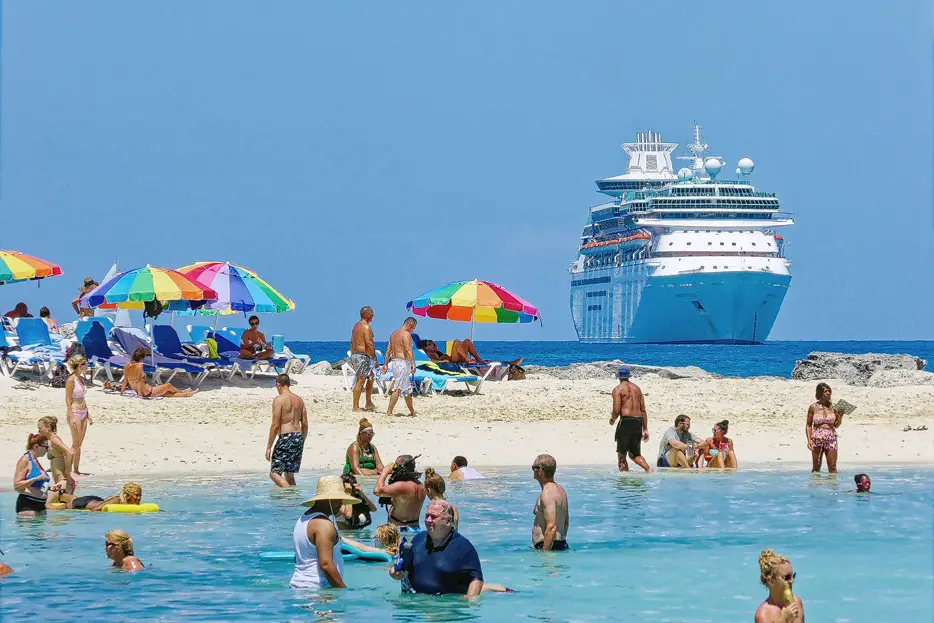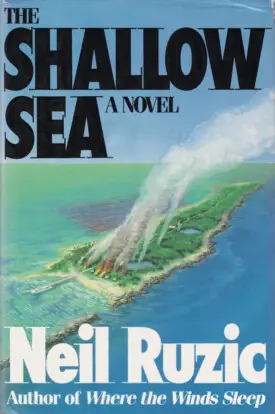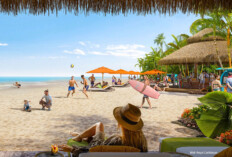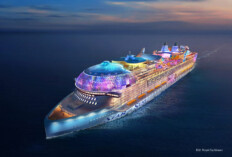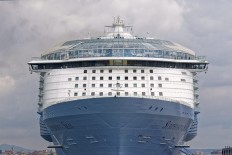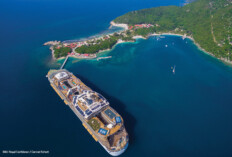Pirate hideout, drug stash, innovative research center: the small Bahamas island of Coco Cay aka Little Stirrup Cay has a charming history before it became a private dream island for Royal Caribbean cruise passengers, and starting 2024 for Celebrity Cruises as well. Our intensive research and knowledgeable sources reveal what you definitely didn’t know about Coco Cay.
This article is also available in German – Dieser Beitrag ist auch auf Deutsch verfügbar: „Die faszinierende Geschichte der Kreuzfahrt-Privatinsel Coco Cay, die eigentlich etwas ganz anderes werden sollte“.
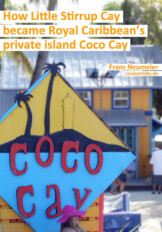
Note: We have researched intensively, talked to eyewitnesses, visited Coco Cay a couple of times over the years – and gathered so many exciting facts and talked to so many sources that its far beyond of what we can pack into this article. Exclusively in our e-book „How Little Stirrup Cay became Royal Caribbean’s private island Coco Cay“ you can read even more details that even insiders do not know about Coco Cay so far – now available through Amazon.com for just $3.49.
Whether the notorious pirate Captain Blackbeard ever set foot on the small Bahamas island of Little Stirrup Cay in the 17th century is unknown. However, the small island may well have served as a pirate hideout. In the 18th century, it was probably also a transit station in the slave trade, albeit an insignificant one.
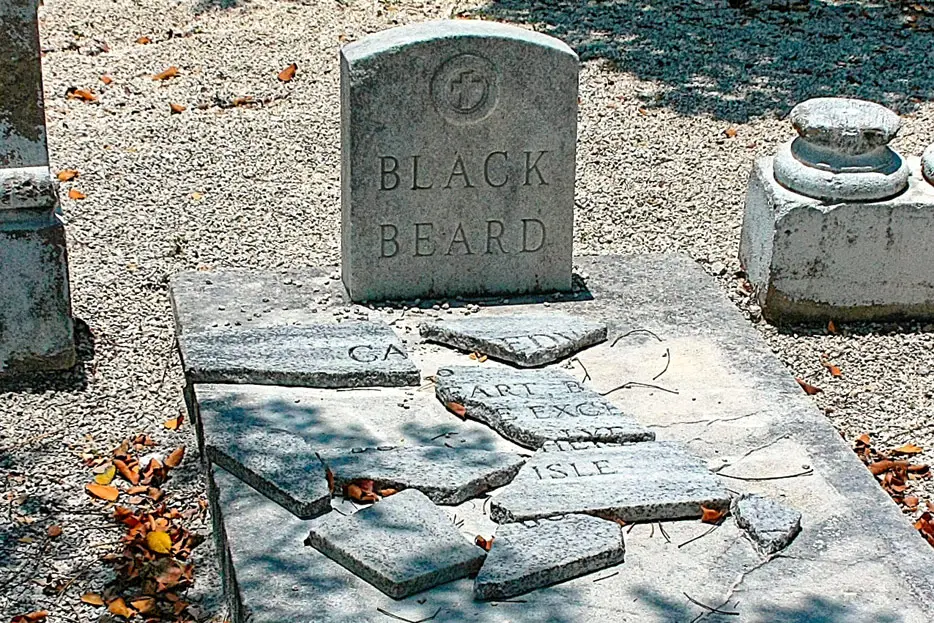
It is certain that drug couriers of the Colombian Medellín cartel used the island in the 1980s as a temporary storage facility for cocaine and marijuana. This circumstance was indirectly to play an important role in the development of Little Stirrup Cay into today’s private island „Coco Cay“ of the Royal Caribbean Group.
content of this article:
- Sleeping beauty, somewhat hidden next to the bigger neighbor of Great Stirrup Cay
- 1972: Little Stirrup Cay to become an innovative research center
- Dan Meyer, the Robinson Crusoe of Little Stirrup Cay
- „The Shallow Sea“ – the island gets its own novel
- The beginnings of Little Stirrup Cay aka Coco Cay as a cruise private island
- 1985: Admiral Cruises acquires Little Stirrup Cay
- Acquired by Royal Caribbean in 1988, rebuilt by 1990, and renamed „Coco Cay“
- Coco Cay from 1994 to 2018: evolution before revolution
- 2018/2019 – The conversion of Little Stirrup Cay to „Perfect Day at Coco Cay“
- How Coco Cay has changed from the beginning in 1983 to today, 2023
- And what about the original flair of the island?
Sleeping beauty, somewhat hidden next to the bigger neighbor of Great Stirrup Cay
Little Stirrup Cay is conveniently located in the Bahamas on the Northwest Providence Channel, which has always been important for shipping, at the northern end of the Berry Islands. At the same time, it has always remained somewhat inconspicuous next to the bigger neighboring island of Great Stirrup Cay. In 1863, the British Empire’s Imperial Lighthouse Service built a lighthouse on Great Stirrup Cay, a helipad was constructed here during World War II, and the U.S. Air Force built a satellite surveillance facility in the postwar period.
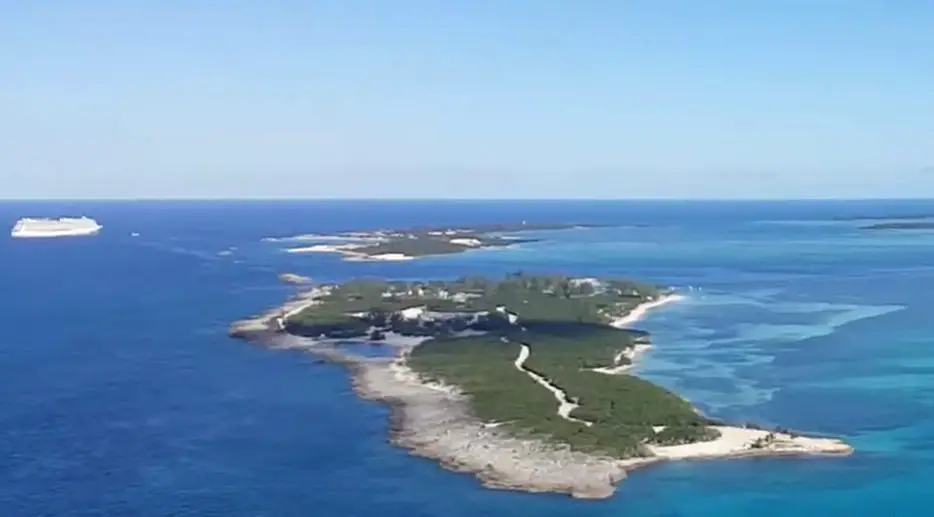
On Little Stirrup Cay, on the other hand, things remained quiet. Even whether the original inhabitants of the Bahamas, the Lucaya, ever settled permanently on Little Stirrup Cay can no longer be determined today. The Lucaya were a branch of the Taino who settled almost throughout the Caribbean for centuries until the arrival of the Europeans. In the Bahamas, by 1520, they were ultimately completely annihilated – enslaved, killed, driven out.
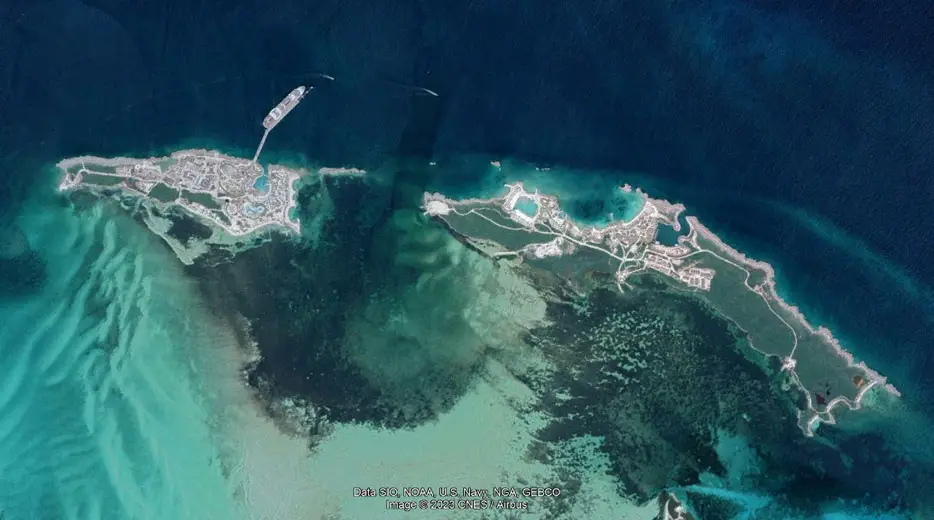
It was not until 1972 that Little Stirrup Cay tentatively awoke from its slumber, even though it would be many years before the island became widely known under its later marketing name „Coco Cay“. Actually, Little Stirrup Cay was supposed to become something completely different.
1972: Little Stirrup Cay to become an innovative research center
In 1972, the renowned American science journalist and scientist Neil P. Ruzic discovered the island’s convenient and secluded location for a revolutionary idea: Little Stirrup Cay was to become an „Island for Science“ – a place for research into alternative energy production, sustainable shrimp aquaculture, pharmaceutical agents on corals and much more.
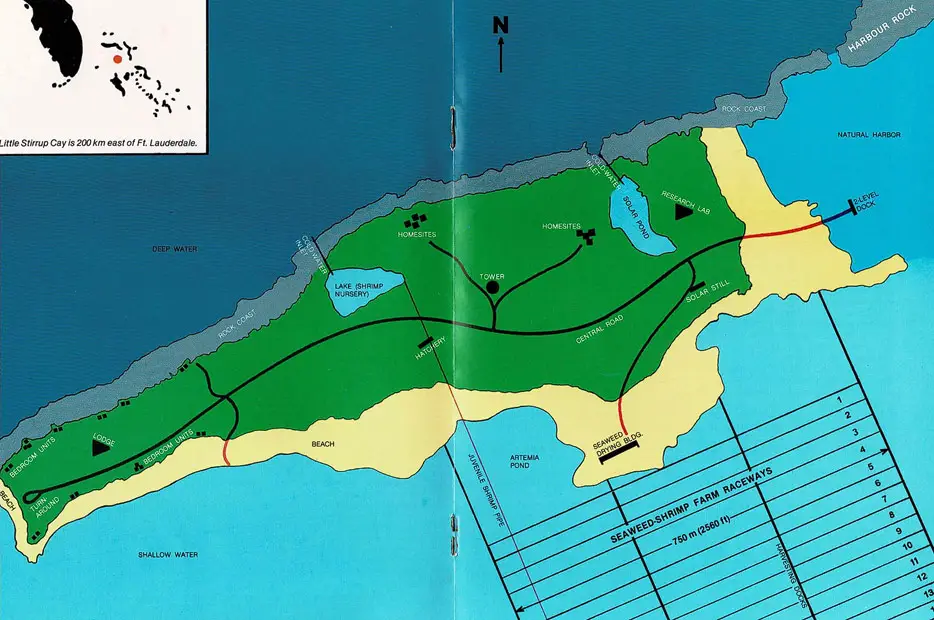
Ruzic had just sold his highly successful science publishing company, founded in 1959, and invested part of the proceeds in Little Stirrup Cay, which he bought from an American private individual – for $600,000, according to media reports at the time. He had been searching for the ideal location for his project for about two years.
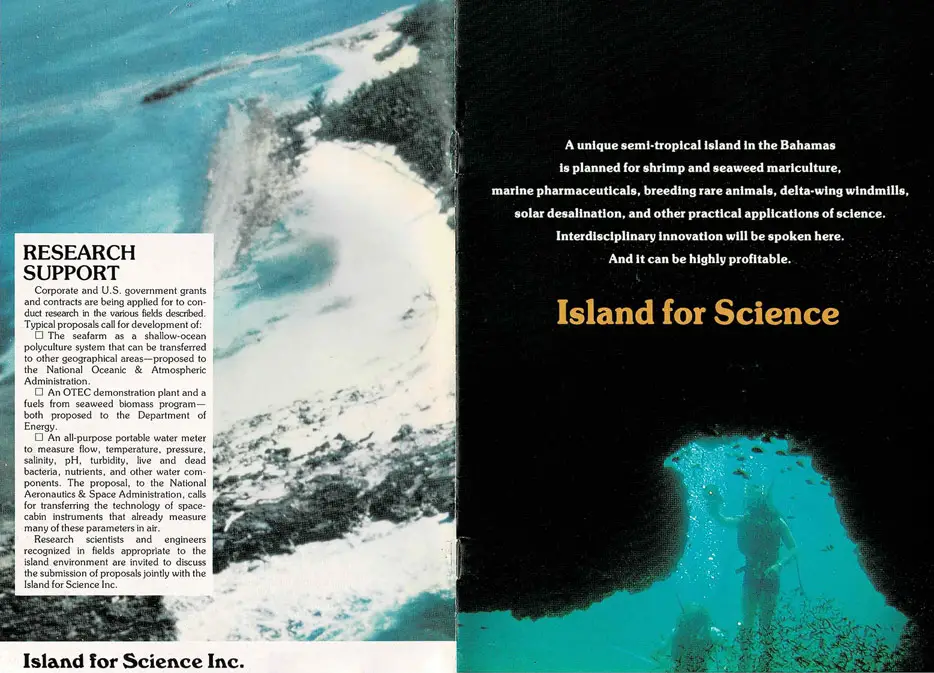
At the time, Neil P. Ruzic sees the beauty of the island more as a pleasant bonus. Later, he will write in a brochure for potential investors: „Not all coral islands are beautiful. This one is.“
The north coast of Little Stirrup Cay is rough and rocky, the sea drops steeply on this side of the island and reaches a water depth of about half a mile. There are beaches to the east and south, the bays in front are very shallow and sandy. The island is overgrown by a low subtropical jungle. There are two small, marshy brackish lakes.
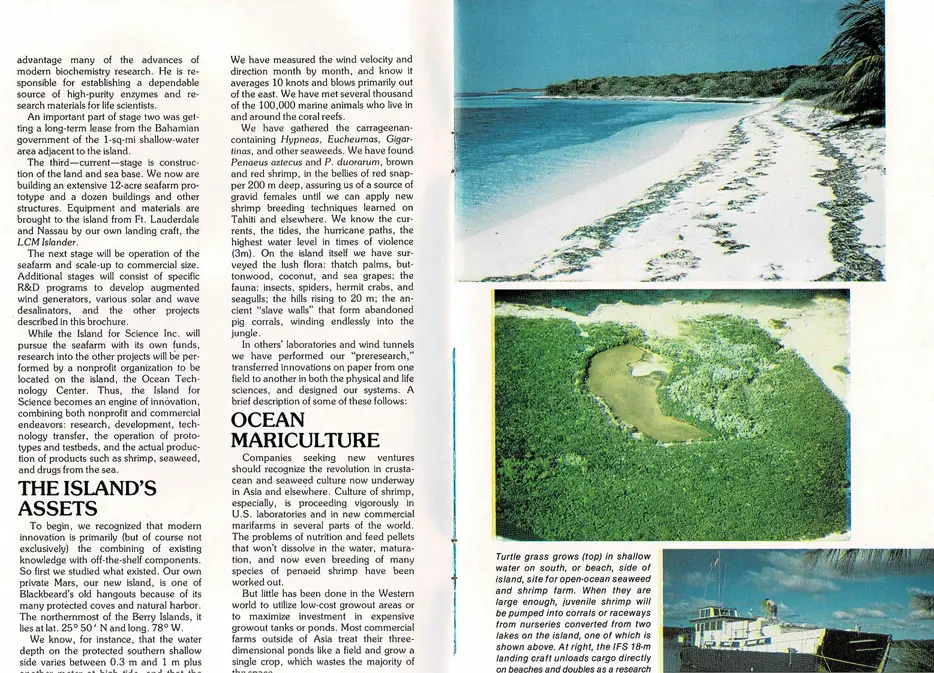
When Neil Ruzic buys the island, he also documents the flora: sea grape (Coccoloba), coconut palms (Cocos nucifera), reed palms (Thrinax), buttonwood bushes (Cephalantus). It finds insects, spiders, hermit crabs and gulls on the island. In the shallow waters in the south of the island can be found, among others, numerous conch shells, Caribbean lobsters, sand sharks.
The highest elevation on the island is 20 meters above sea level. In jungle Ruzic finds old „slave walls,“ historic stone fences for pigs (possibly they were also goats, as another source suggests) that „wind endlessly through the jungle,“ as Ruzic writes.
Remains of walls from the island’s prehistory can still be visited today, even though they are not marked on Royal Caribbean’s map of the island (tip: the ruins can be found in the bushes next to the path between the Helium Balloon and the Thrill Waterpark area).
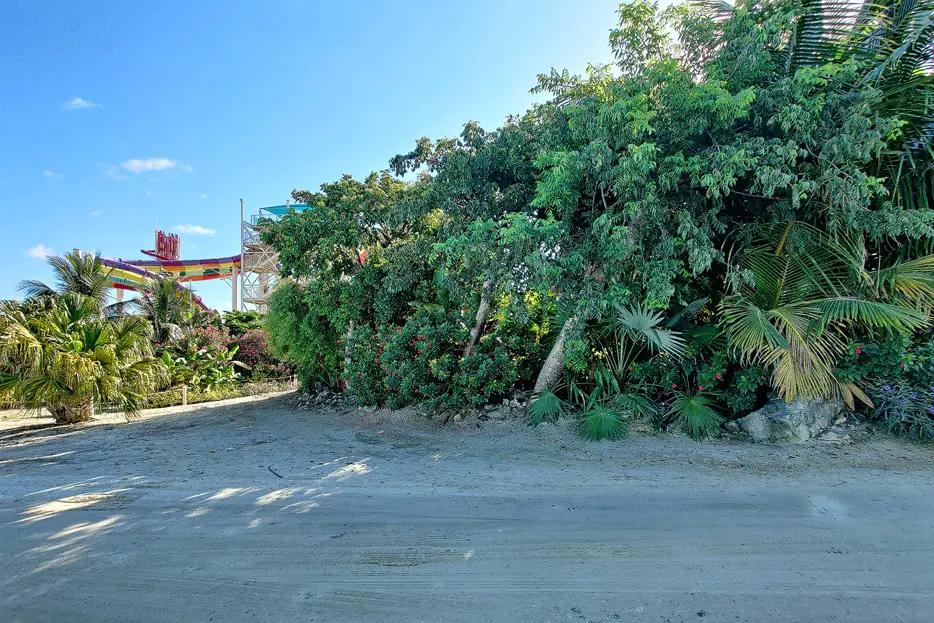
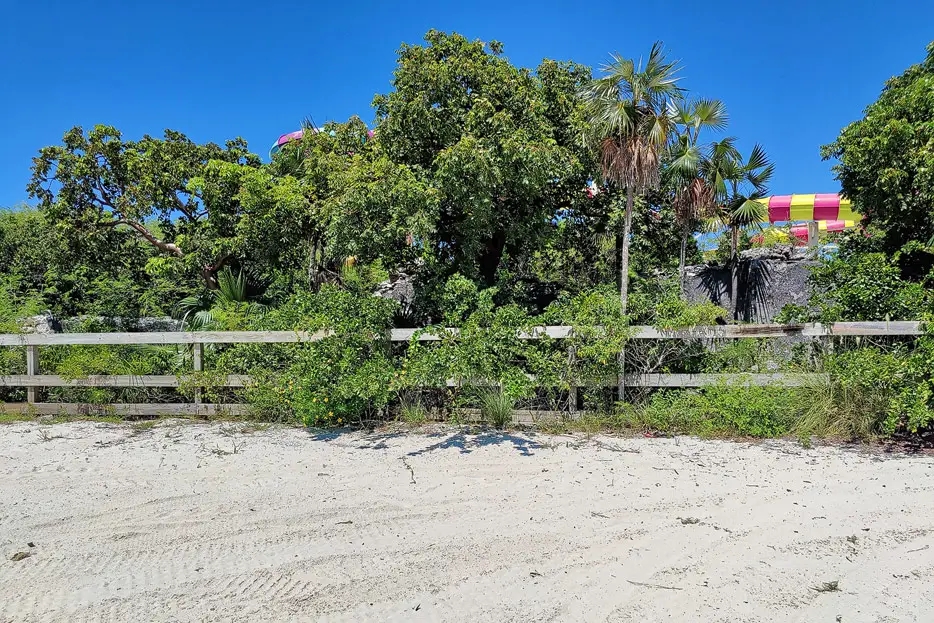
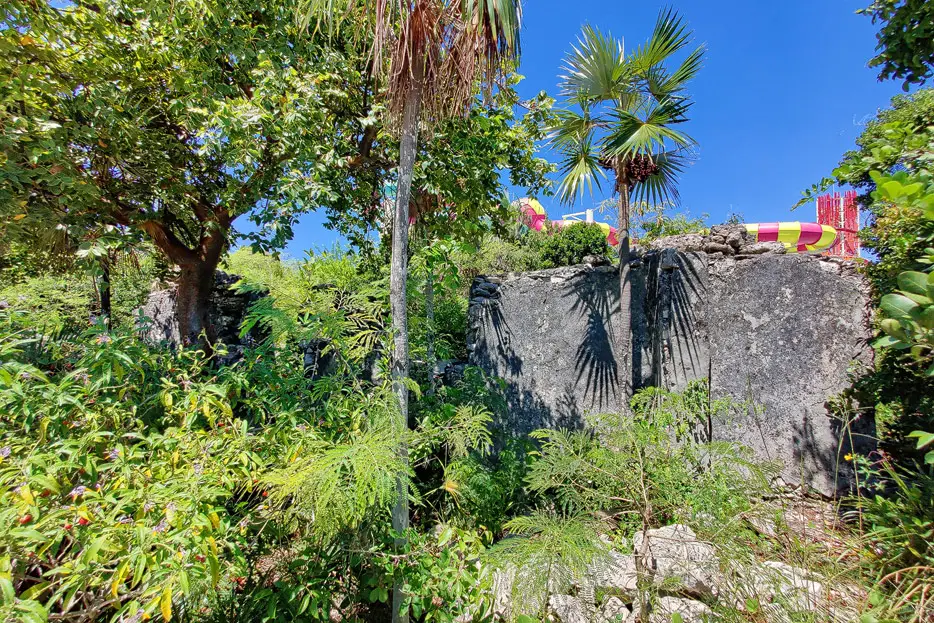
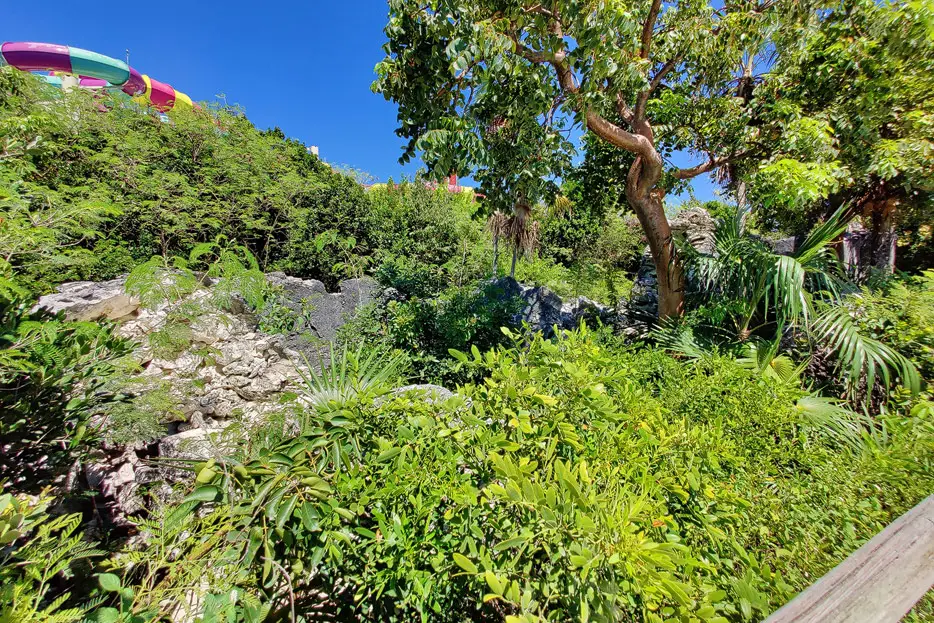
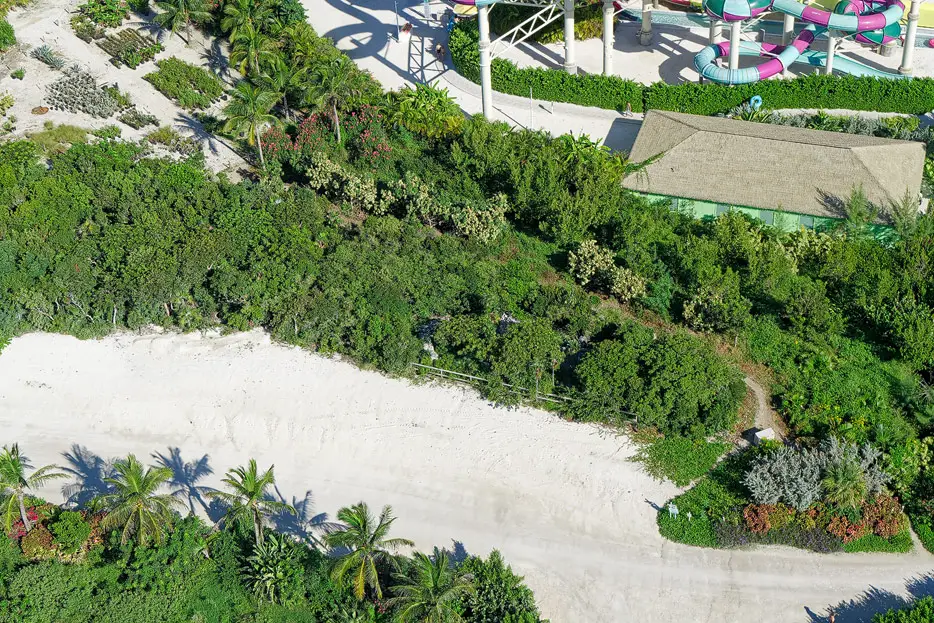
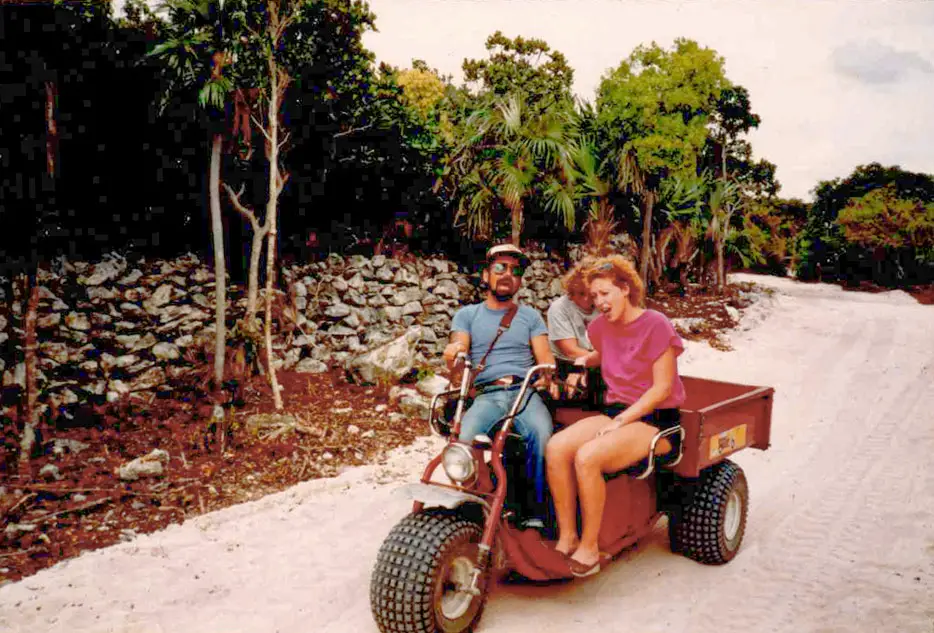
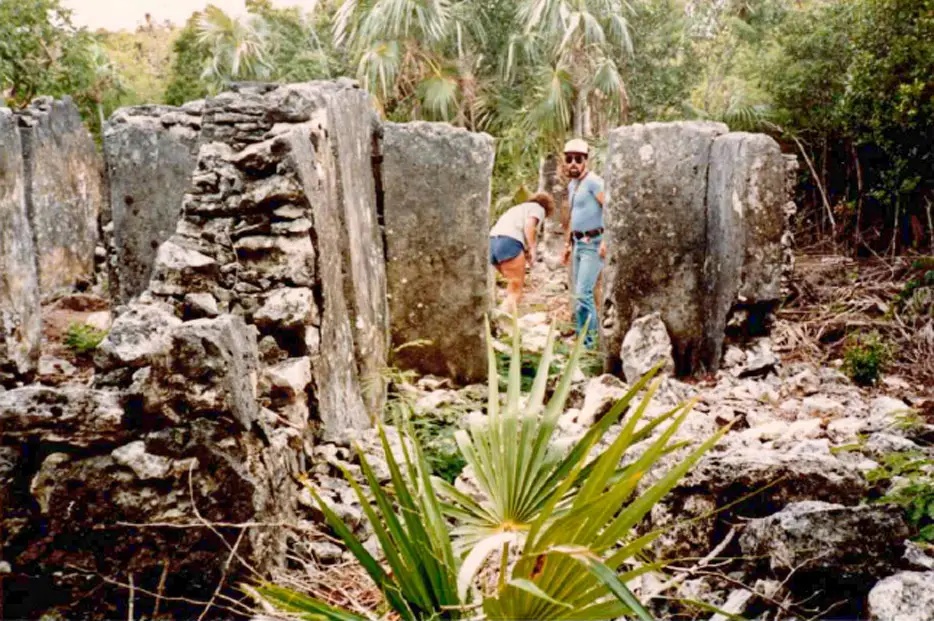
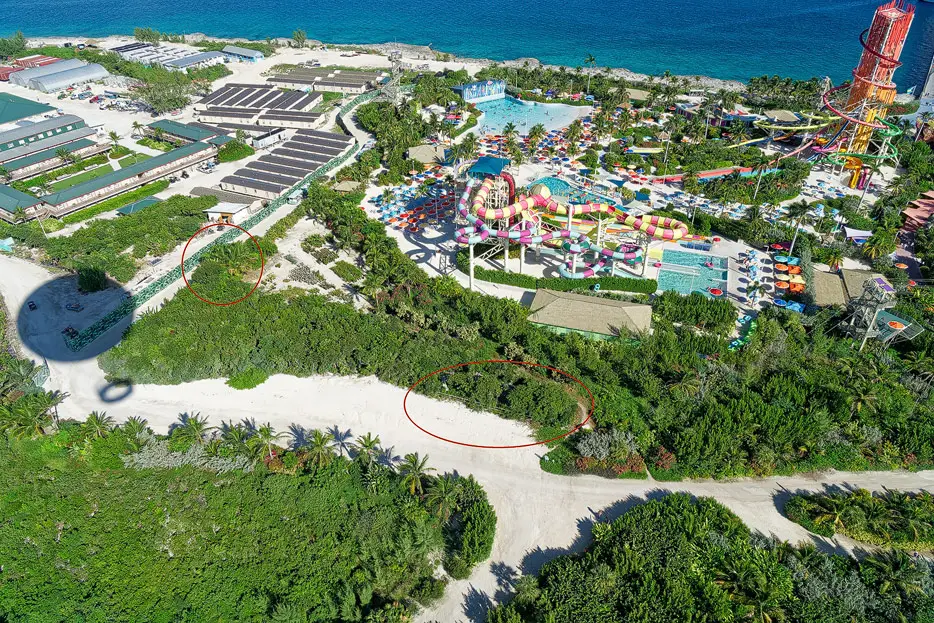
Ruzic was way ahead of his time with the „Island for Science“ concept. The research projects he wanted to tackle on Little Stirrup Cay would have been groundbreaking for the time. And his consistently interdisciplinary approach to research was also very unusual back then.
But Neil P. Ruzic was not just any scientist. Involved in the Nasa space program for a long time, he would have liked to fly to the moon himself on one of the Apollo missions. In 1963, he published the highly acclaimed book „The Case for Going to the Moon.“ For another book Ruzic published in 1970, „Where the winds sleep – man’s future on the moon, a projected history,“ none other than Wernher von Braun wrote the foreword. The Youtube „How One Book Saved Apollo“ portrays Ruzic and his importance to the U.S. space program.
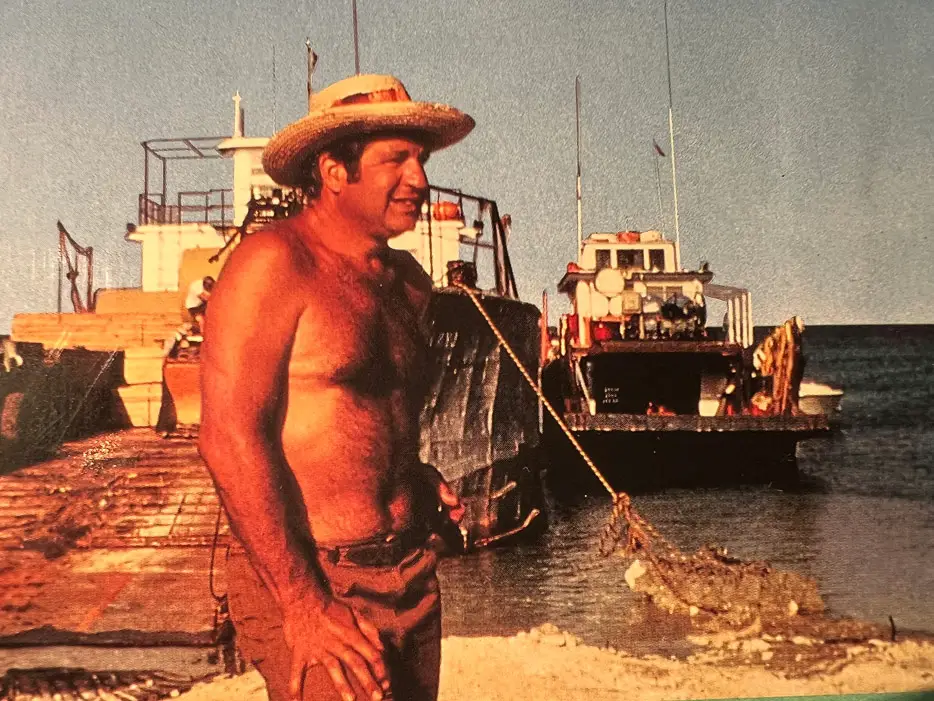
The two books, more than 50 years ago, deal with the establishment of a base on the moon, among other things as a starting point for missions to other planets such as Mars. In 1960, Ruzic was awarded a U.S. patent for a device called the Lunar Cryostat, which can preserve samples from the lunar surface at a consistently extremely low temperature.
But for his very earthly project „Island for Science“ on Little Stirrup Cay, things were to turn out differently than he had dreamed.
Dan Meyer, the Robinson Crusoe of Little Stirrup Cay
The years in which Neil P. Ruzic worked on building the „Island for Science“ are connected with a dazzling personality: The present sword swallower and motivational speaker Dan Meyer lived for several years on Little Stirrup Cay. In motivational speeches like this, he demonstrates how his time on Little Stirrup Cay, among other things, helped him overcome fears in his life.
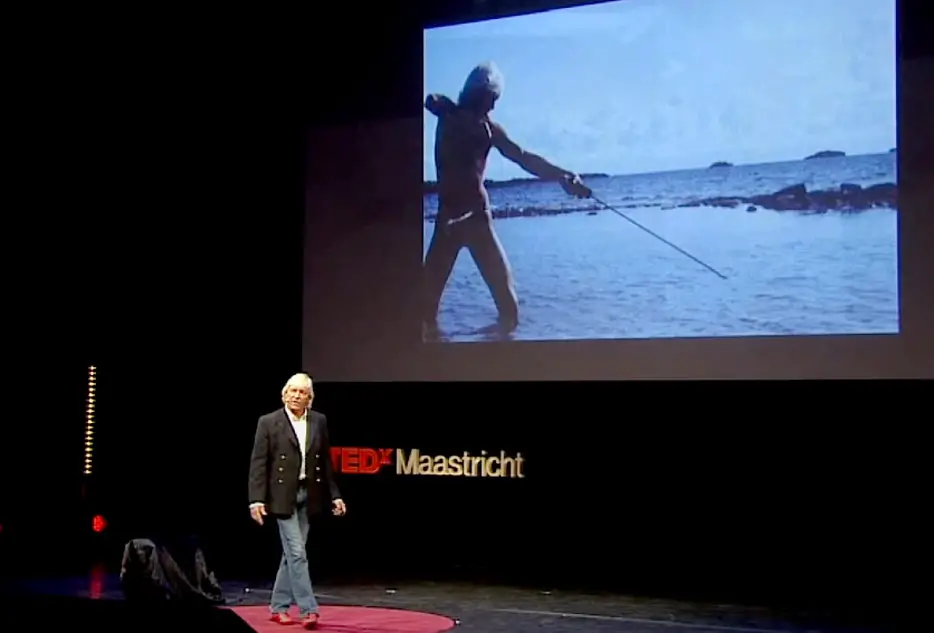
The Ruzics had hired David Ruzic’s high school friend to keep an eye on the island, because it was obviously in dire need of it. Neil P. Ruzic’s son David says, „We started building some things, like a small cabin. The problem was that when you leave something like that unattended for many months, it disappears – literally. Every board was dismantled by people from near islands and used for their buildings.“
From 1979 to 1983, Dan Meyer therefore spent time on Little Stirrup Cay, most of the time alone and on his own. On a now inaccessible homepage, Dan Meyer wrote about his time on Little Stirrup Cay: „I lived in a thatched hut, cooked over a campfire, ate coconuts, and whatever sharks, stingrays, grouper, or lobster I could spear, and basically lived like Robinson Crusoe. Most of the time I wore a Tarzan loincloth, and my hair got bleached really blonde from the sun and salt water.“
„The Shallow Sea“ – the island gets its own novel
Neil P. Ruzic later describes how he tried to implement his big ideas on Little Stirrup Cay in a thriller entitled „The Shallow Sea“. The story does not have a happy ending: Ruzic reports on the ignorance of the authorities, persistent corruption and drug trafficking in the Bahamas. They shattered his dream of a science island.
„Truth throu fiction“ reads the dedication in the copy of the novel that Cruisetricks.de has. And the author’s son, David N. Ruzic, says, „Two-thirds of it is completely true!“
The cover of the novel is a drawing, not a photograph. It shows a densely vegetated island with two natural lakes and the algae and shrimp farm in the shallow bay on the lee side of the island, which was supposed to become an important part of the research project there.
Part of the island’s buildings are on fire in the painting – a symbol of the project’s failure, even though the end of the story was much less dramatic in reality than in the novel.
The book was published in 1992, by which time Neil Ruzic and his wife Carol had long since abandoned the „Island of Science“ idea and instead had begun to focus on pirate island romance and scavenger hunts for sun-starved cruise ship passengers.
David Ruzic recounts the bitter experience of failure: „By 1980/81 or so, we gave up on getting business permits from the Bahamian Government. We had building permits – and hired local people to do most of the construction I mentioned, but the only two businesses the government recognized were drug smuggling and tourism.“
For the Ruzics, there was only one choice for what to do next with Little Stirrup Cay, David says: „We chose tourism and bought out our island-for-science investors.“ It’s the end of the research island and the beginning of Coco Cay as a private island for cruise tourists.
The beginnings of Little Stirrup Cay aka Coco Cay as a cruise private island
Leased since 1977 and purchased since 1988, Norwegian Caribbean Line (now NCL) was already using the neighboring island of Great Stirrup Cay. It is the early beginning of a trend that continues to this day: Private islands and private beaches exclusively for cruise ship passengers. The idea of having an „out-island“ in the Bahamas all to oneself inspired the Robinson Crusoe and pirate fantasies of cruisers even back then.
Nevertheless, it took a surprisingly long time for the idea to find imitators. Even though the tall ship Fantome of the casual-luxury Windjammer Barefoot Cruises anchored near Little Stirrup Cay for snorkeling and diving at least as early as 1975 or 1976. Some of the ship’s mere 30 to 50 passengers took a tender boat to the island to snorkel from there.

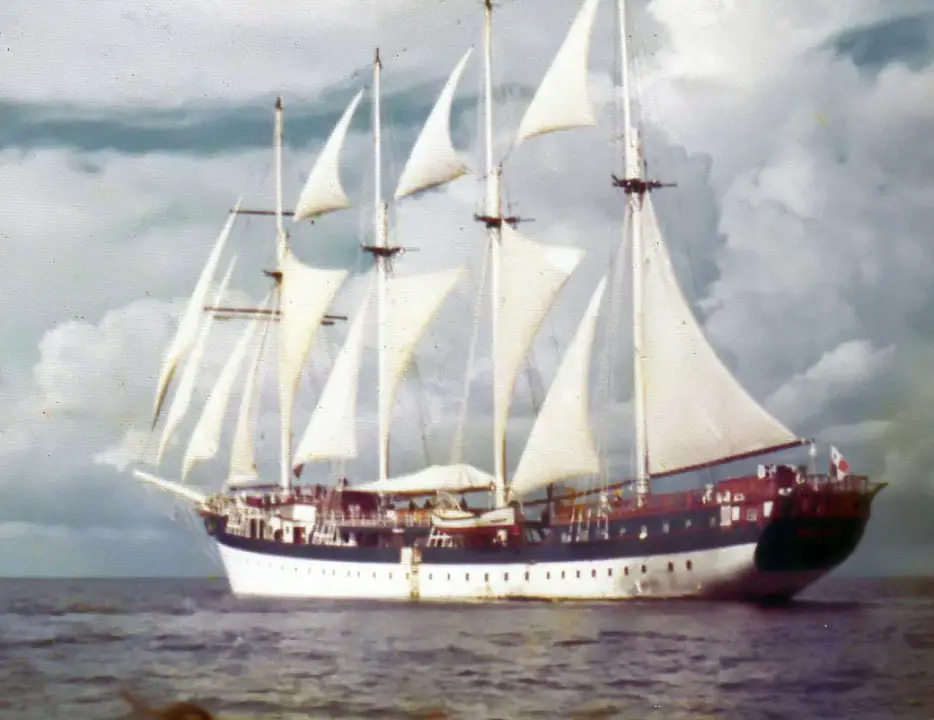
In 1983, the Emerald Seas, with a capacity of up to 1,000 passengers, was the first large cruise ship by the standards of the time to drop anchor off Little Stirrup Cay and take its passengers by to the dream island with palm trees and white sandy beaches by tender boats. The Ruzics received ten dollars per passenger from the cruise line, David Ruzic recalls.
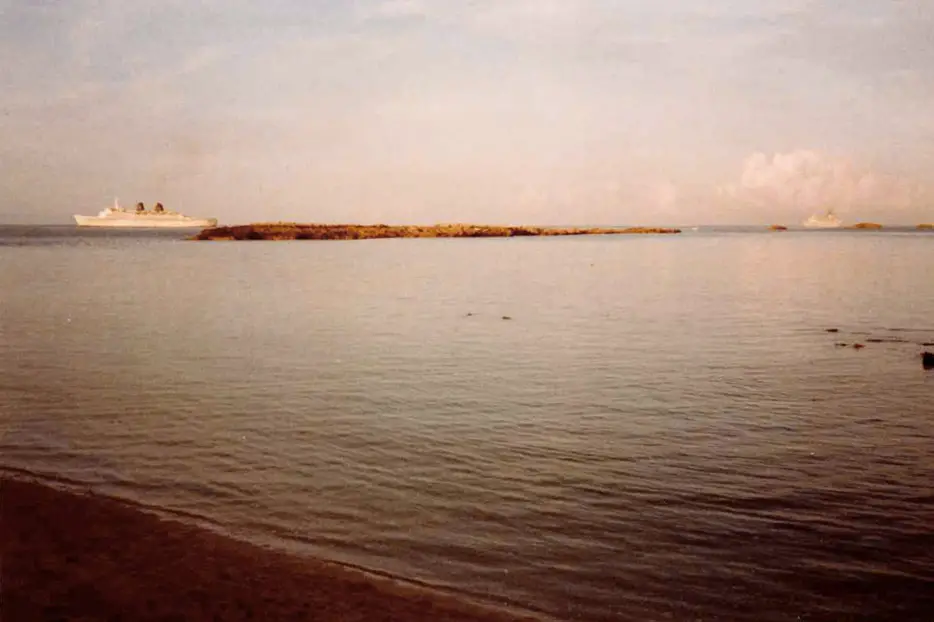
Canadian Cathy Reed remembers the Emerald Seas‘ first calls on Little Stirrup Cay. Together with her husband, she spent some time as a dive and snorkel instructor on Little Stirrup Cay starting in 1983:
„Eastern Cruise Lines decided to make some changes to its itinerary to be more competitive in the cruise business going out of Miami and into the Bahamas. They came up with the ‘Super Cruise’, which they launched in 1983.
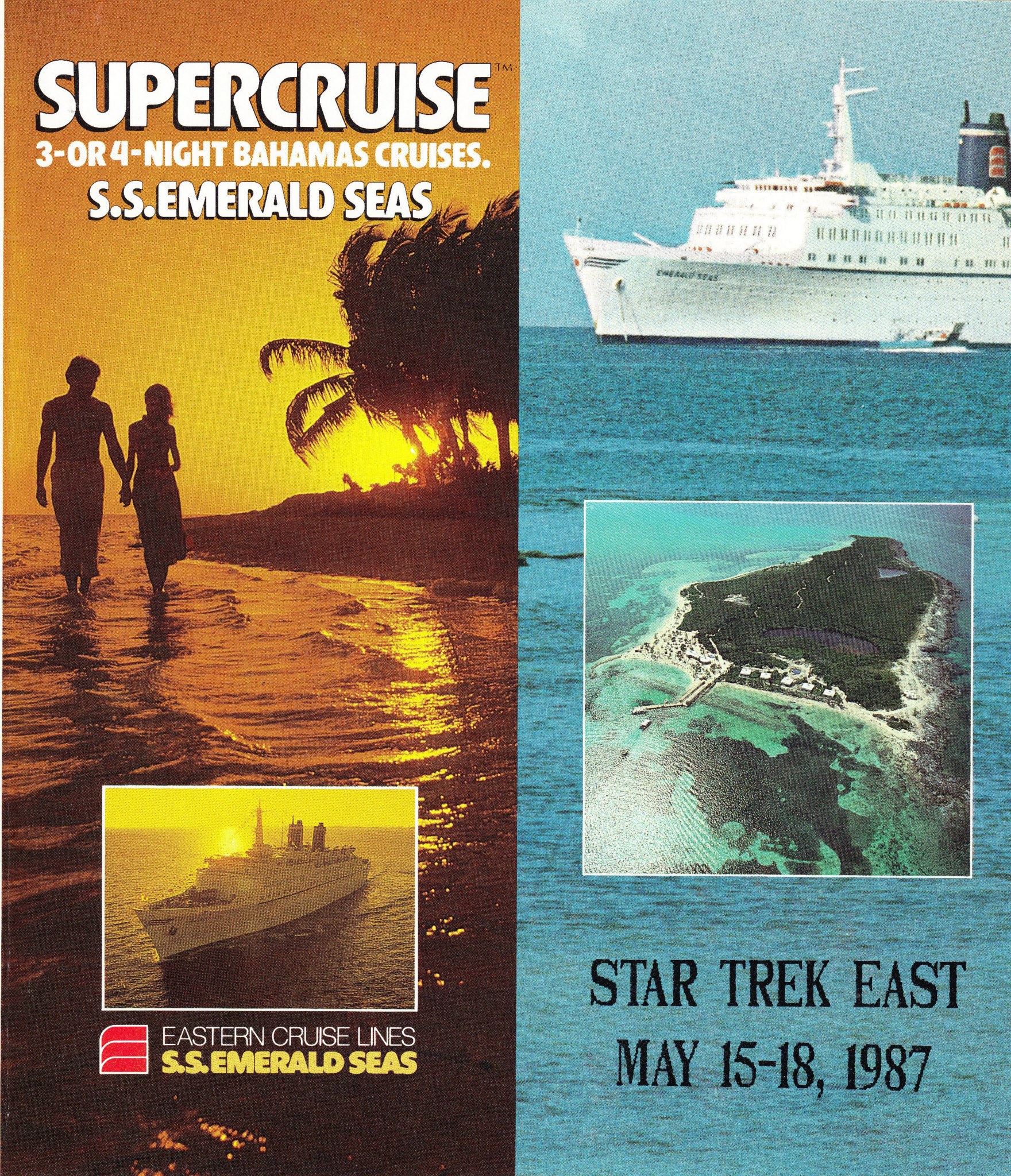
The cruises consisted of three- and four-day excursions from Miami to Nassau, Little Stirrup Cay, Freeport and a day at sea“ …
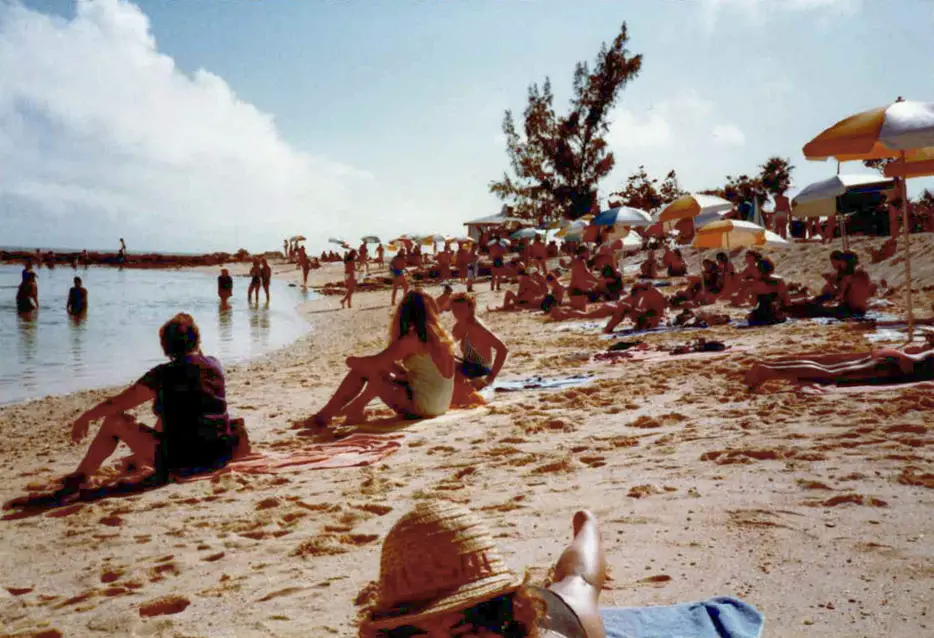
… „The stop at Little Stirrup Cay was a highlight for most of the passengers and was promoted as such. A private Bahamian out-island with sandy beaches, great snorkeling and water sports, beach games, barbecued lunches, bar, jungle walks to ancient ruins – it was something to look forward to and to treasure, once experienced.“
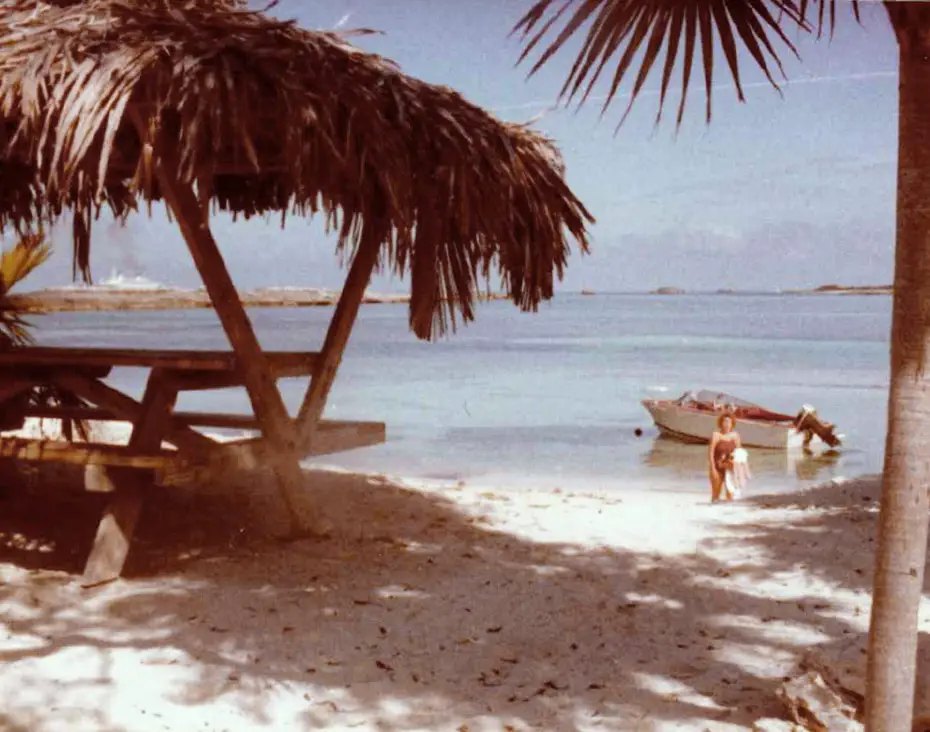
What Little Stirrup Cay had to offer as a private island in those early days was very limited. „We did call it our own private island, but it was so underdeveloped, it really didn’t have too much of anything. And then the passenger load wasn’t that big either,“ says Ken Rush, who was assistant cruise director on the 1,000-passenger Emerald Seas ship at the time and is now entertainment director at Royal Caribbean. But „everybody thought it was very charming. Everybody thought it was absolutely perfect. They didn’t need any more.“
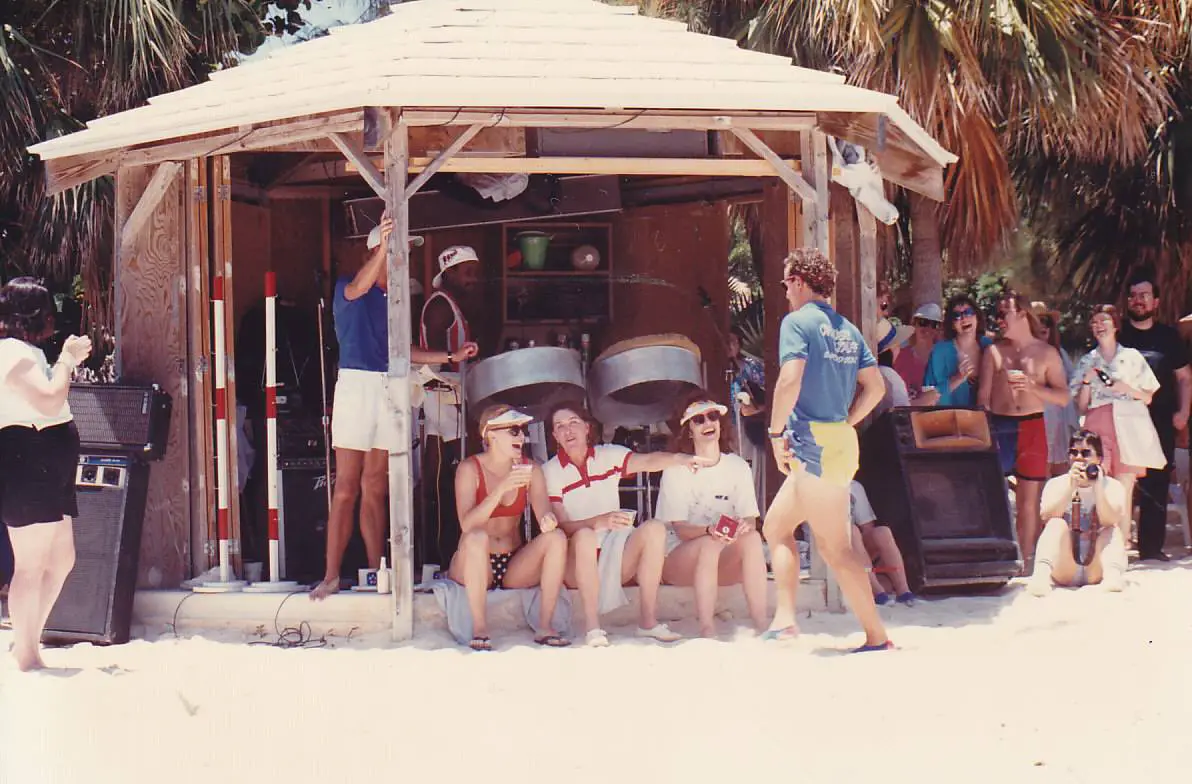
Al Parker, then engaged as a singer on the Emerald Seas, also documented how the island presented itself at that time. In December 1988, he shot a video that can be found on Youtube. It shows Little Stirrup Cay (from timecode 15:46) as well as the Emerald Seas and some impressions of the port stop in Nassau.
1985: Admiral Cruises acquires Little Stirrup Cay
In 1985, Neil P. Ruzic finally sold most of Little Stirrup Cay to the newly emerging cruise line Admiral Cruises – a merger of Eastern Cruise Lines (Emerald Seas), Western Cruise Lines (Azur Seas) and Sundance Cruise Lines (Stardancer). Admiral Cruises, in turn, merged in 1988 into Royal Caribbean Cruise Line, today’s Royal Caribbean Group.
David Ruzic tells how it came to the sale of the island at that time: „My dad talked to other ships, too, to sell out every day. Some smaller ones took him up on the offer. Soon, Admiral bought Eastern and wanted an exclusive to the island. Once we started talking to Admiral’s direct competitors, they decided to buy the island in a hurry.“
The Ruzic family retained a small piece of land on Little Stirrup Cay in the sale, about five acres of the total 140-acre island. „We preserved the right to ‘roam’ the whole island and also be able to do what cruise passengers could do.“ David Ruzic says.
On these five acres, roughly in the middle of the island between the two small lakes, the Ruzics built a two-story vacation villa with a hexagonal floor plan, about 5,000 square feet, in 1988.
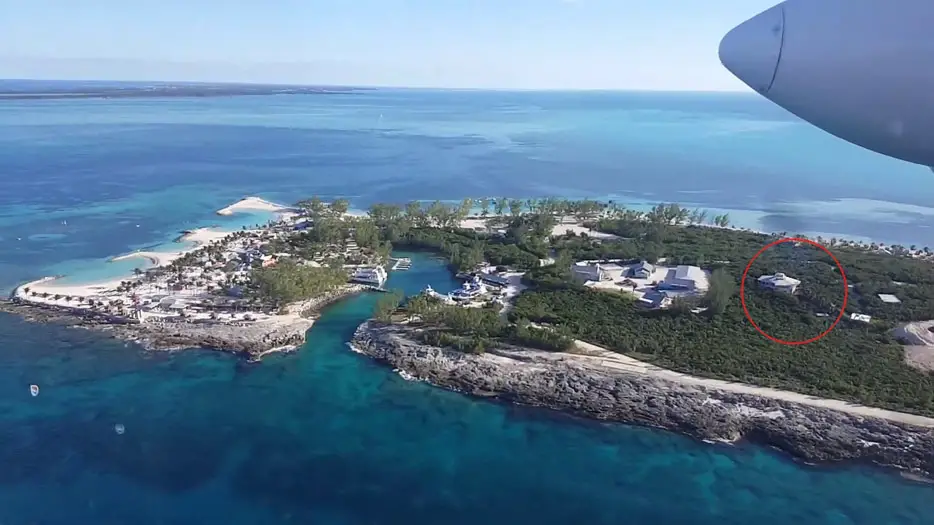
A system for collecting and filtering rainwater not only provided enough fresh water to supply the villa, but was also enough to fill a swimming pool. So Neil P. Ruzic was able to implement a few of the ideas for the „Island for Science“ here, at least for his own villa. And so the Ruzic family continued to spend some time each year on Little Stirrup Cay.
Acquired by Royal Caribbean in 1988, rebuilt by 1990, and renamed „Coco Cay“
Admiral Cruises thus had the small Bahamas island exclusively from 1985 and initially also only for the passengers of the Emerald Seas. Initially, Admiral Cruises did not make any noteworthy changes on Little Stirrup Cay.
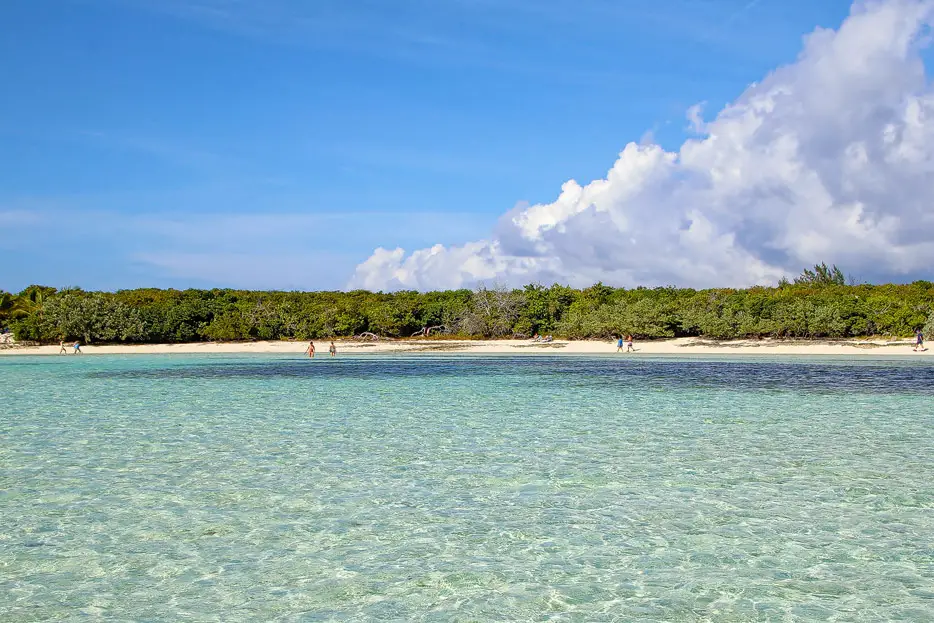
In 1988, Admiral Cruises was taken over by Royal Caribbean and with it Little Stirrup Cay. The cruise company soon began with larger reconstruction measures, which essentially were completed by 1990. At that time, Royal Caribbean invested a total of seven million dollars in the expansion of the island.
In 1990, the island also got a new name: „Coco Cay“. For marketing purposes, Royal Caribbean has consistently used the name Coco Cay since then, even though the geographical name of the island remains „Little Stirrup Cay“.
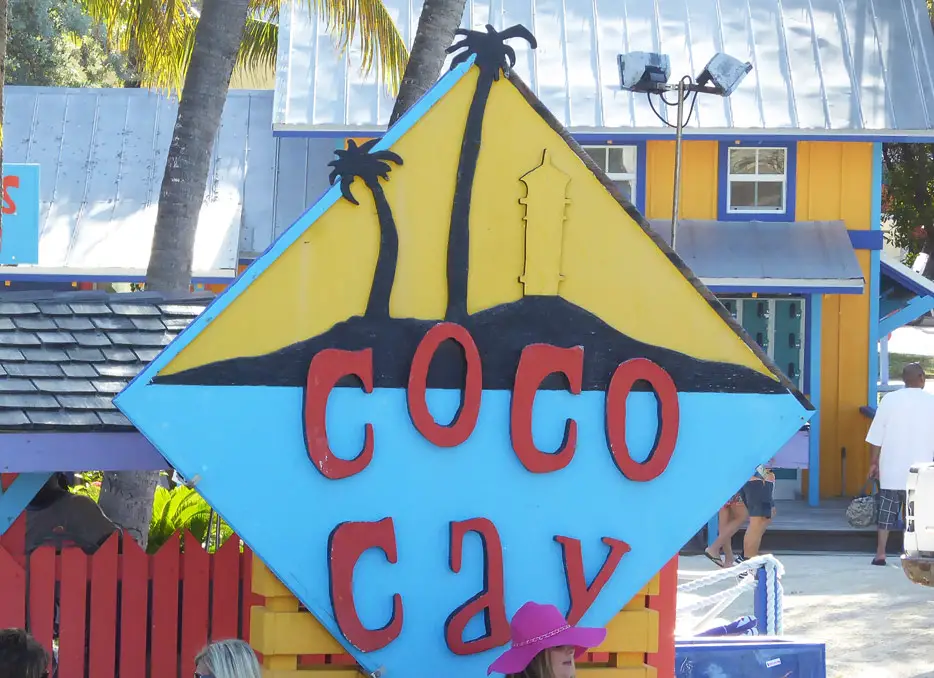
To better protect the northeast end of the beach from erosion, Royal Caribbean constructed a low wall, the „seawall,“ and a stylized lighthouse, the Lighthouse Tower, with a small observation deck, east of the entrance to the tender harbor.
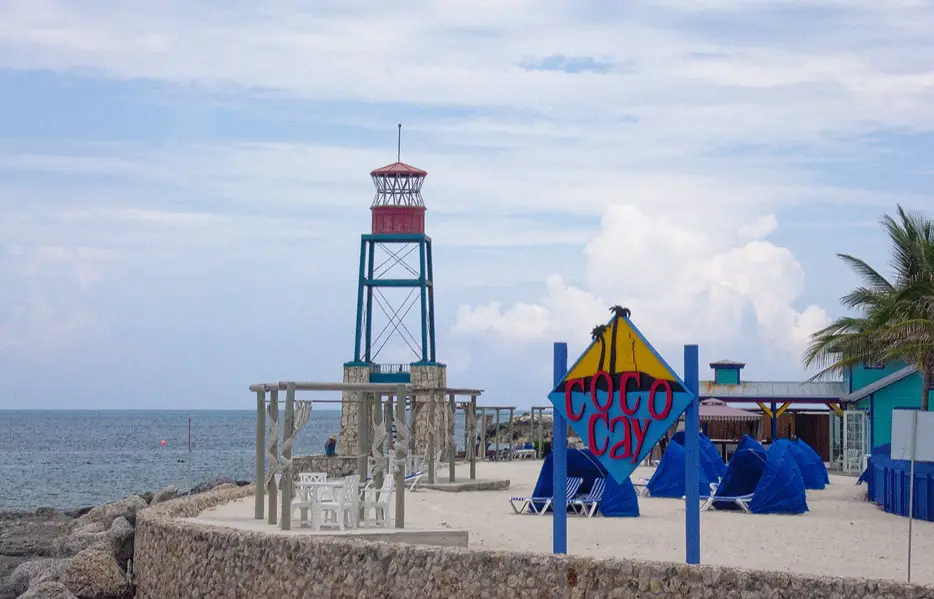
The seawall also gives the northeastern corner of the island the flair of a sea promenade in the partial shade of some coconut trees. Of course, the Lighthouse Tower never served as a real lighthouse. It was demolished during the major reconstruction of the island in 2019.
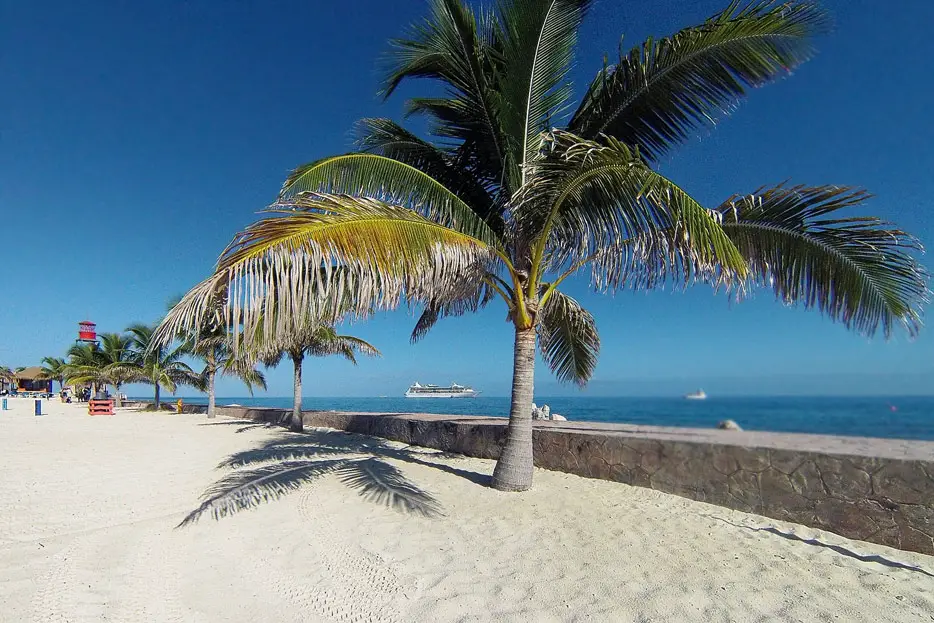
A dedicated port for tender boats and the mermaid Caylana
Until 1988, the cruise company had only used the area of the island east of the marshy lake, as well as beaches on the south side. The tender boats took passengers from the anchorage of the ships north of the island to a wooden pier at a beach to the east. This was not ideal, because in this area were also the most popular parts of the beach, most notably for snorkeling.
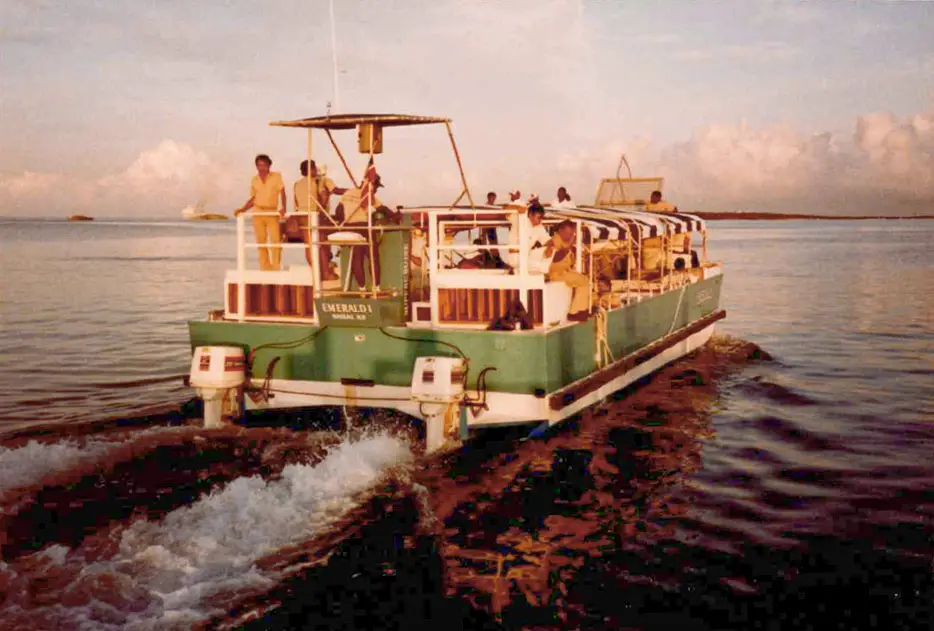
Therefore, the eastern of the two lakes on the island has now been dredged and a breakthrough to the sea has been created in the north – a small, protected harbor, in other words, into which tender boats could enter. During the major reconstruction of the island in 2019, not needed anymore as such, the tender harbor became Harbor Beach.
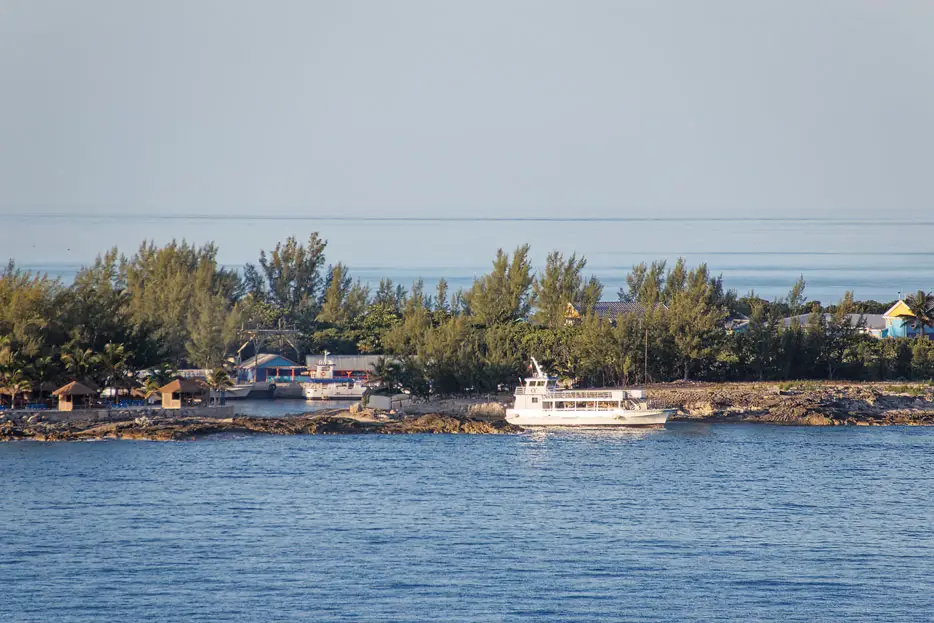
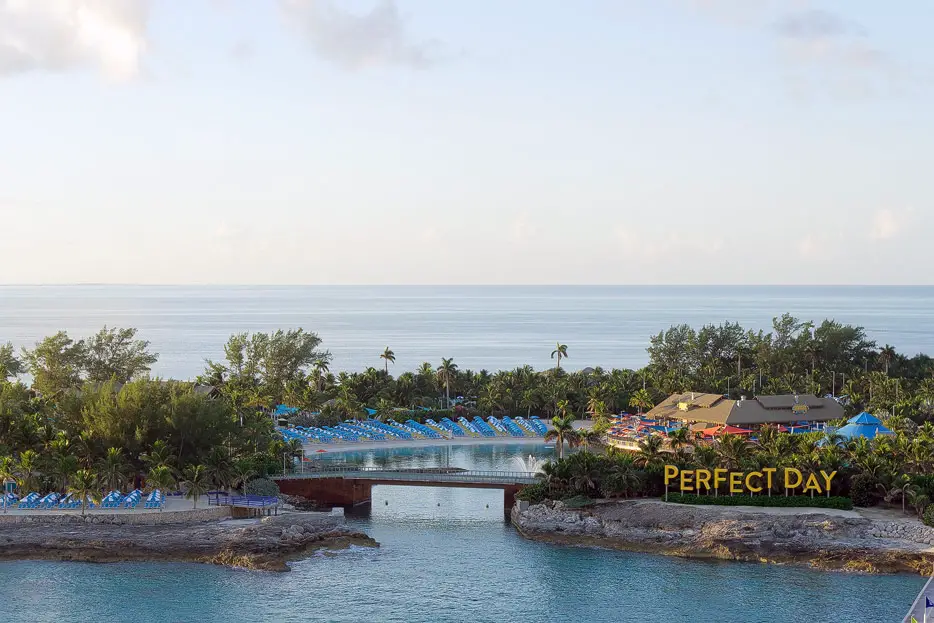
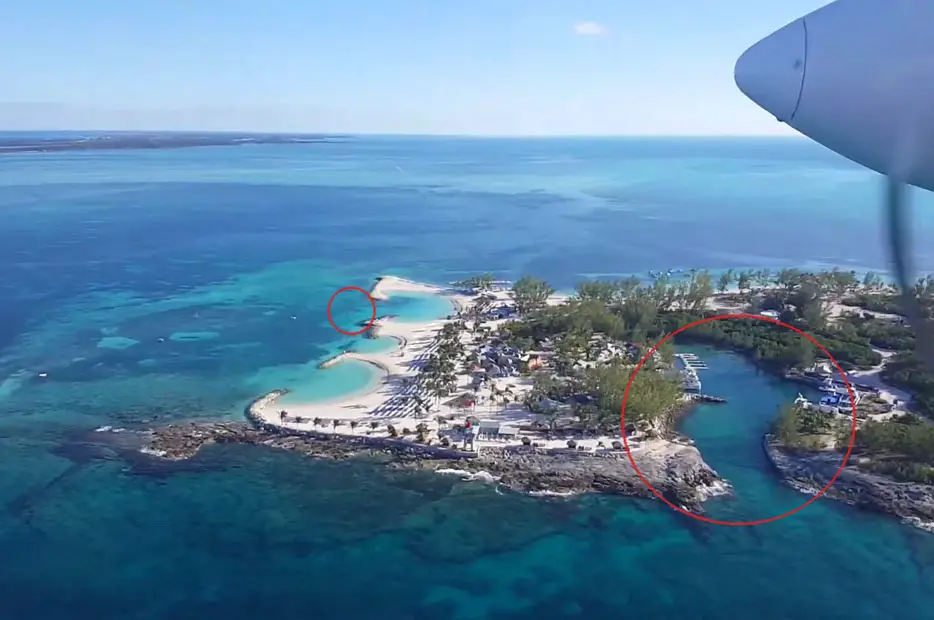
A loving detail in the tender port: near the pier for the tender boats, a bronze mermaid about three meters tall in a small fountain called „Caylana“ greeted the arriving passengers. Royal Caribbean had commissioned the statue from the renowned sculptor Kathy Spalding (1952 to 2014).
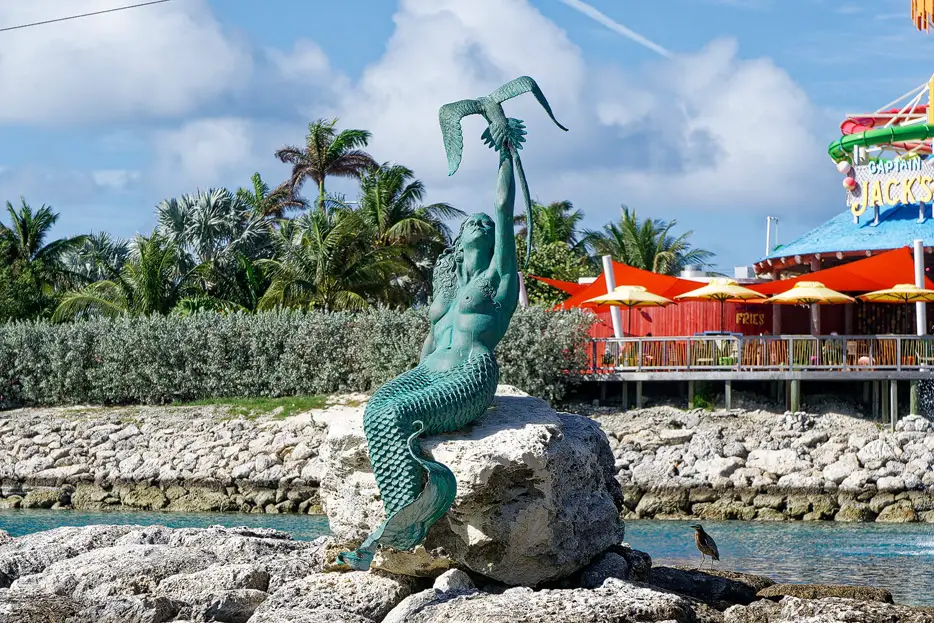
During the island redevelopment starting in 2019, the mermaid was removed, but returned to nearly the same location on what is now Harbor Beach in late December 2022.
Sunken plane as snorkel attraction
Off the stretch of beach to the east that cruise tourists already use for snorkeling right off the beach, there is a small plane in about five meters depth as an artificial coral reef, according to the Seattle Times sunk there by Royal Caribbean. However, the aircraft has probably been there since at least 1983, well before the cruise line came to the island. It’s said to be a drug smugglers‘ plane shot down there by the Bahamian Defense Force.
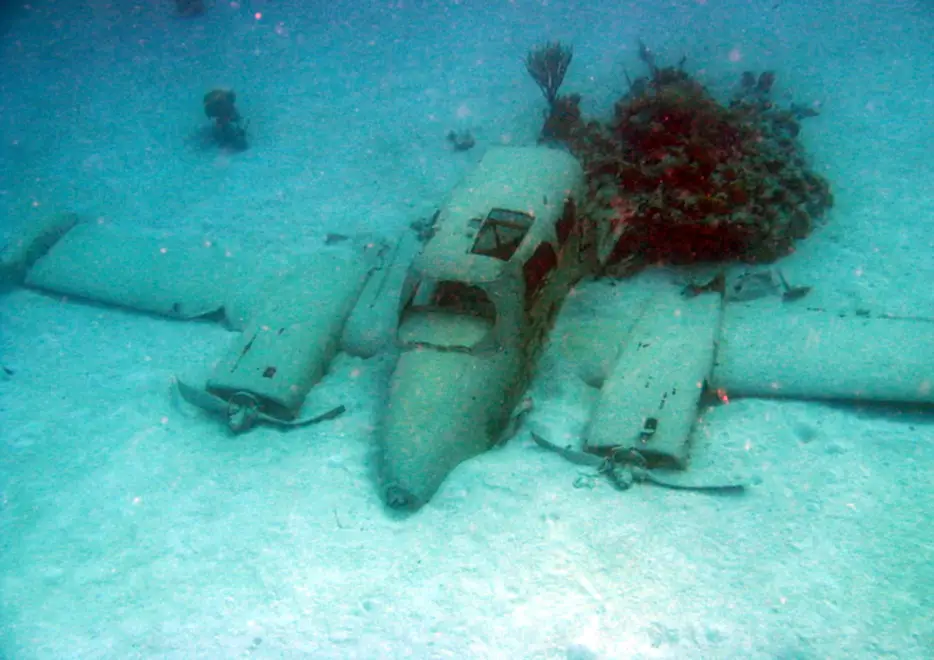
In the 1994 article, the author notes that Little Stirrup Cay is especially popular with snorkelers because, in addition to the plane wreck, a concrete replica of the 16th century pirate ship of the infamous Captain Blackbeard – called „Queen Anne’s Revenge“ – has become a habitat for tropical fish and other marine life. In addition, there is also a natural coral reef for snorkeling in front of the island, he wrote.
The wreck of the plane can still be found there today, although it is now outside the snorkeling area. Some remains of the pirate ship, however, can still be discovered while snorkeling, as a Youtube video from 2021 shows (from timecode 5:22):
Coco Cay from 1994 to 2018: evolution before revolution
Over the next 15 years or so, Royal Caribbean continued to develop Coco Cay, also known as Little Stirrup Cay, with new attractions being added from time to time. It is not until 2019 that the island experiences an extensive expansion of attractions and new beaches.

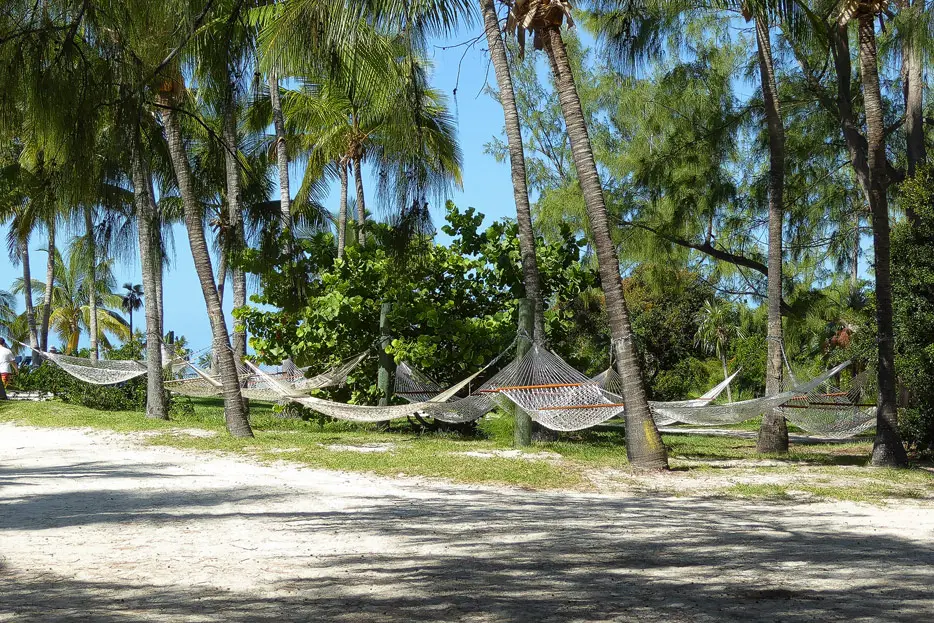
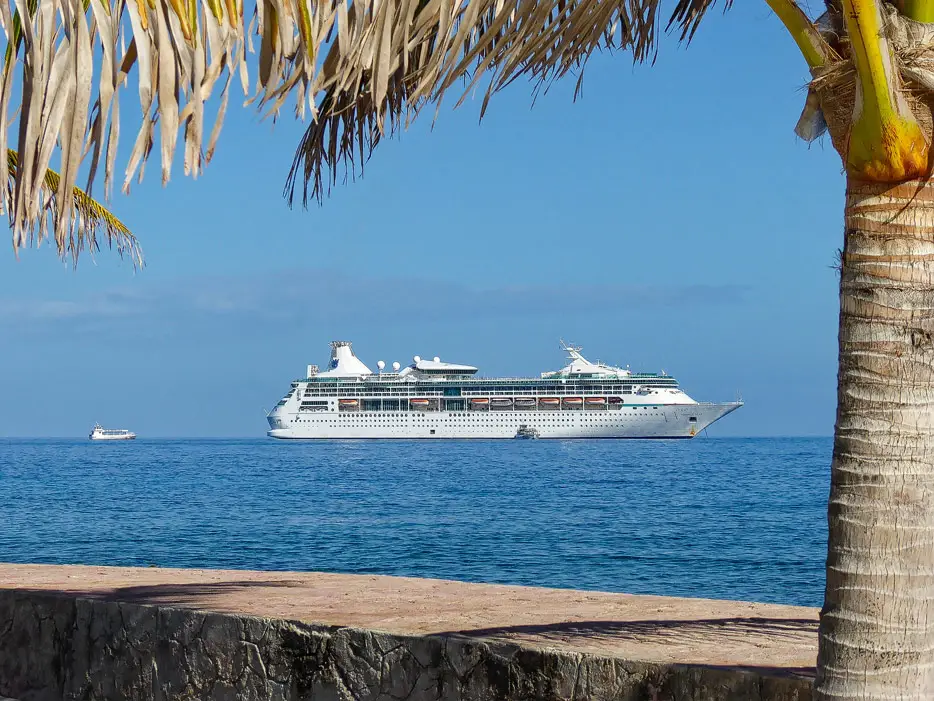
In 1994, Coco Cay has several bars, food and beverage pavilions, Nassau „Straw Market“ style vendor booths, a small „Adventure Ocean“ kid’s area, a stage with live Caribbean music, beach volleyball, and various water sports activities such as snorkeling, scuba diving, parasailing, glass bottom boat tours, kayak tours, floating mats rentals, pedal boats and wave runner jet skis.
2003: Caylana’s Castle Cove – water playground in front of the island
In March 2003, Royal Caribbean and Celebrity Cruises, in sponsorship cooperation with the Coca-Cola Company, open a new type of water playground off Coco Cay with an investment of over $100,000. The 1,860-square-meter water park at Coco Cay, called „Caylana’s Castle Cove,“ featured, among other things, two inflatable castles more than four meters high with slides on one side and climbing walls on the other, two trampolines 25 feet meters in diameter, or inflatable bobbing animals that look like giant hot dogs on a bun. In a separate area, there is something similar for smaller children.
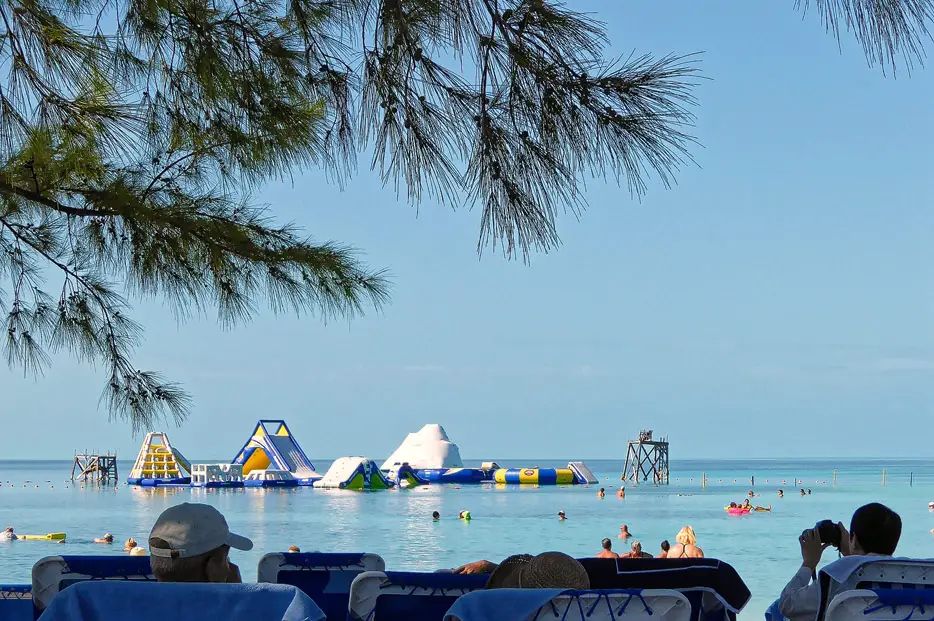
Initially, the Aqua Park was located in the southernmost of the three bays on the east coast of the island. By the beginning of 2010 at the latest, this inflatable water park was relocated in front of a southern beach, not far from the landing pier for the wave runner jet skis.
And no later than 2010, Royal Caribbean is also launching an inflatable „Seatrek Water Slide“ waterslide near Caylana’s Castle Cove on the beach, advertised at the time as one of the largest slides of its kind in the world at just over 175 feet long.
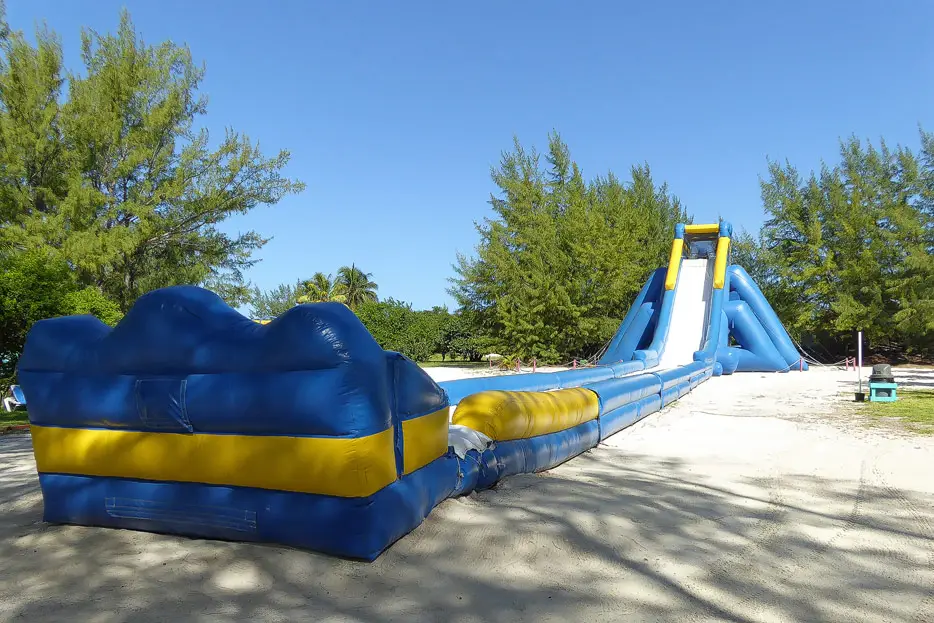
The water park was there until the opening of the now land-based giant water and slide park „Thrill Waterpark“ and children’s water playground „Splashaway Bay“ on Coco Cay after the comprehensive expansion to „Perfect Day at Coco Cay“ in 2019.
Cabanas and Island Oasis Cabana Club
Over time, Royal Caribbean introduced some upgrade options for the beach experience at Coco Cay: For a fee, you can book pre-reserved, comfortable sun loungers or small, covered bungalows on South Beach.
Even more exclusive were the cabanas at the Island Oasis Cabana Club, which was built between 2011 and early 2012 in the northeast of the island near the Lighthouse Tower. In fall 2014, the club expanded to include the entire area around the Lighthouse Tower. One passenger describes her cabana at this beach club in 2014 as „our own private paradise.“
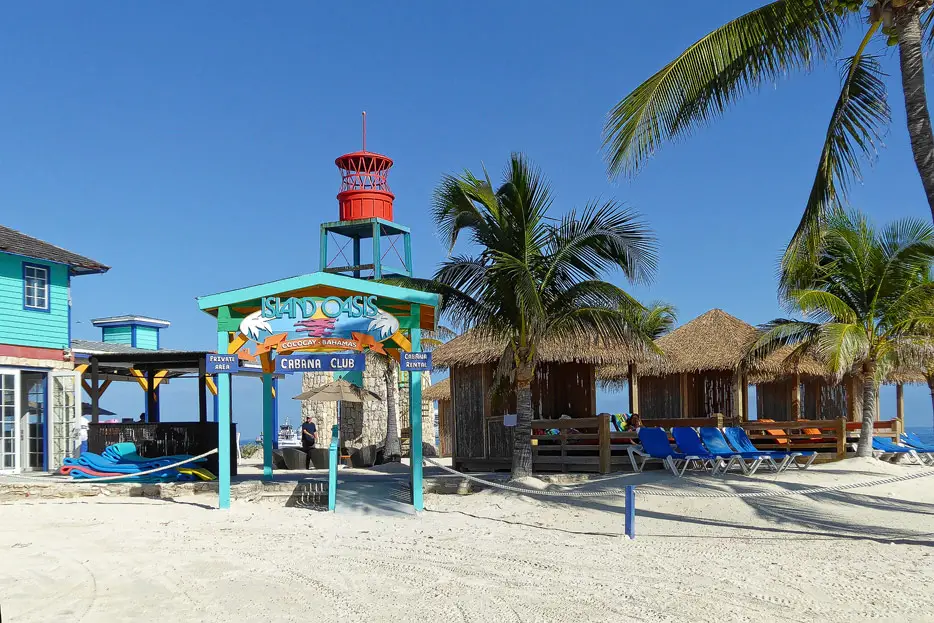
The Island Oasis Beach Club became today’s Coco Beach Club, which was created on the south side of the island when it was rebuilt in 2019.
In 2015, Royal Caribbean opens a swim-up bar in the shallow waters off the island in the westernmost part of Barefoot Beach – now South Beach. This bar continues to exist even after the 2019 renovation.
2016 – The sale of the remaining five acres to Royal Caribbean
Over the years, the Ruzic family had already sold more and more usage time at their vacation home on Coco Cay via timeshare, and most recently had only about two weeks to themselves – until they finally sold the remaining five acres to Royal Caribbean as well.
David Ruzic: „Finally in 2016, the owners of our house sold the house and the last five acres to RCCL, and our chapter of the Island came to a close. For me 1970, when we first looked at islands, including in the Bahamas, to 2016 is ages 12 to 58. So my life was very tied to Little Stirrup Cay.“ Carol Ruzic, her son David and family have not visited Little Stirrup Cay ever since.
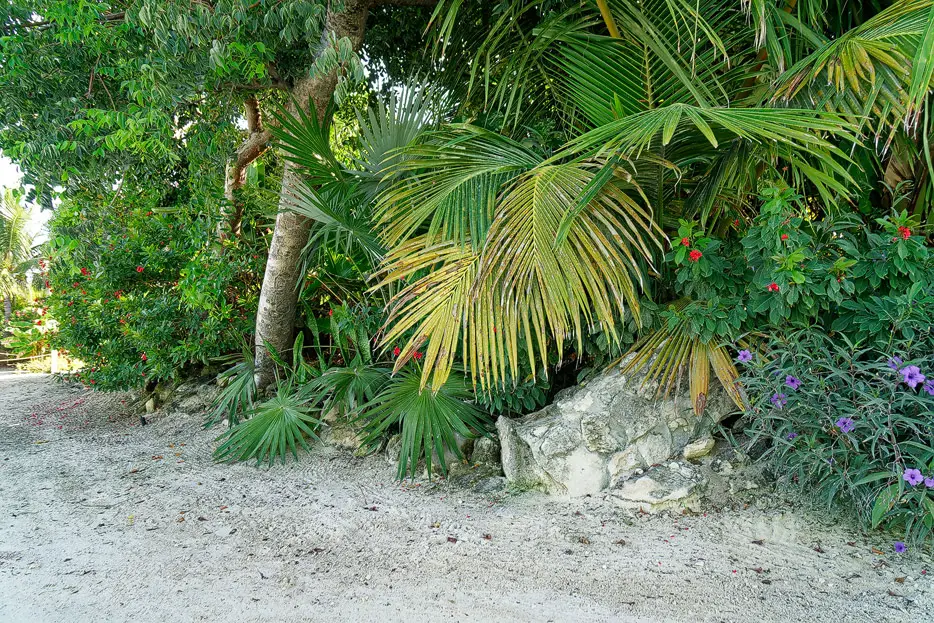
The former vacation villa of the Ruzics finally disappeared during the extensive expansions of the island offer 2019. Remaining today are only a few walls at the former access path to the villa.
The beaches at Coco Cay
Over the years, Royal Caribbean has expanded the island step by step to accommodate more and more passengers at the same time without it becoming too crowded. Especially the beaches on the south side of the island were initially completely untouched, wild, but also unkempt, and not marked on the island plans. But as a passenger, you could roam freely if you didn’t already spread your towel on a deck chair near the tender dock right away.
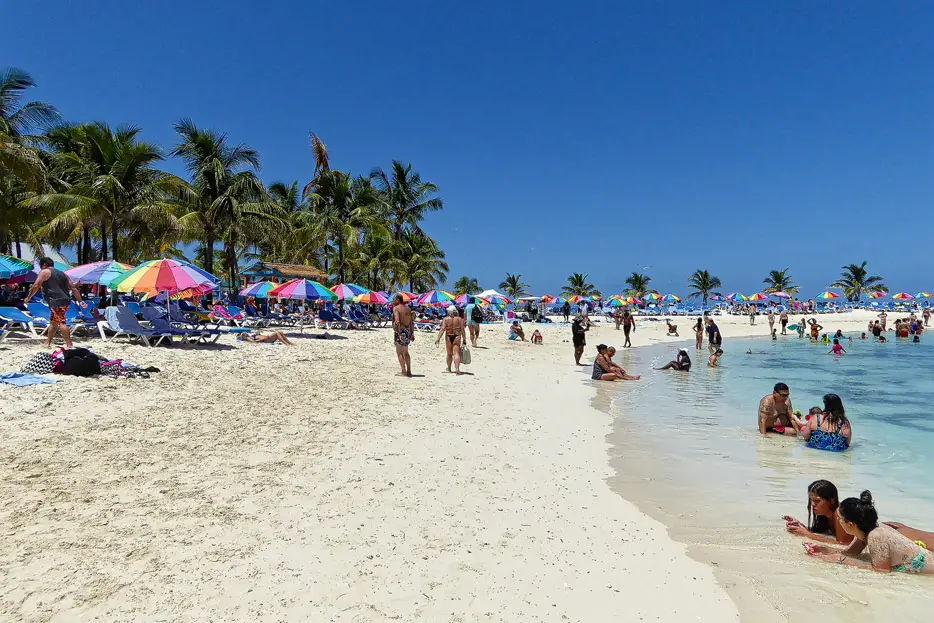
A look at the different beaches of Little Stirrup Cay aka Coco Cay shows how more and more areas became official beaches and gradually got official names as well. The beaches on Little Stirrup Cay aka Coco Cay (clockwise, starting in the northeast):
- New since 2019: Harbor Beach in the lagoon that served as a tender boat harbor before the pier was built
- Snorkel Beach and Water Sports Beach, with the tender pier in between until 1990; combined into Chill Island as of 2019.
- Wanderers Beach, renamed Coconut Willie’s Beach in 2012; as of 2019: Breezy Bay at Chill Island.
- only since 2012 with official name: Barefoot Beach; since 2019 the eastern part is Coco Beach Club, the southern one is called South Beach.
- In January 2024, the new adults-only beach Hideaway Beach opened in the northwest. For this purpose, Royal Caribbean is converting the second lake originally existing on the island into a protected lagoon on what is actually the rocky and rugged north coast.
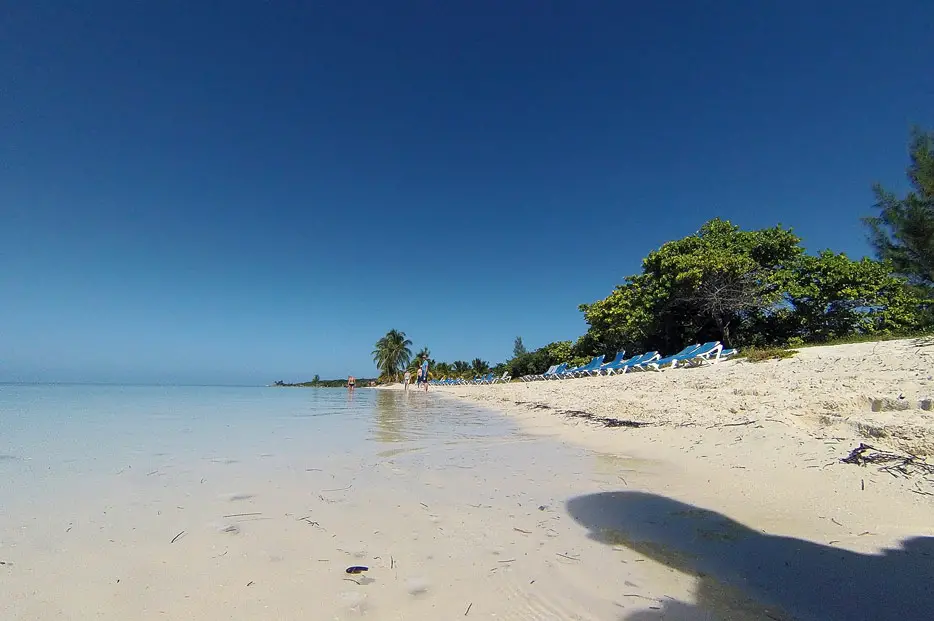
The beaches on Little Stirrup Cay are located on the east and south side of the island, shallow, sandy and protected from the rougher sea on the north side. This is because off the north coast of Little Stirrup Cay, the seabed drops steeply very quickly and the shore is rocky.
2018/2019 – The conversion of Little Stirrup Cay to „Perfect Day at Coco Cay“
In 2018, Royal Caribbean comprehensively began modernizing the existing areas of Coco Cay aka Little Stirrup Cay with an investment of $250 million to They built a pier for the large cruise ships so passengers no longer have to use tender boats to get ashore. To the west of the tender boat port, now Harbor Beach, a kind of amusement park is being created, for example, with spectacular water slides, a large freshwater pool and a zip line around 1,600 feet long (for details, see our article „Coco Cay: Royal Caribbeans ‚Perfect Day*-Privatinsel in den Bahamas“ – in German, but you’ll see the pictures, at least, and you might want to use Google Translate).
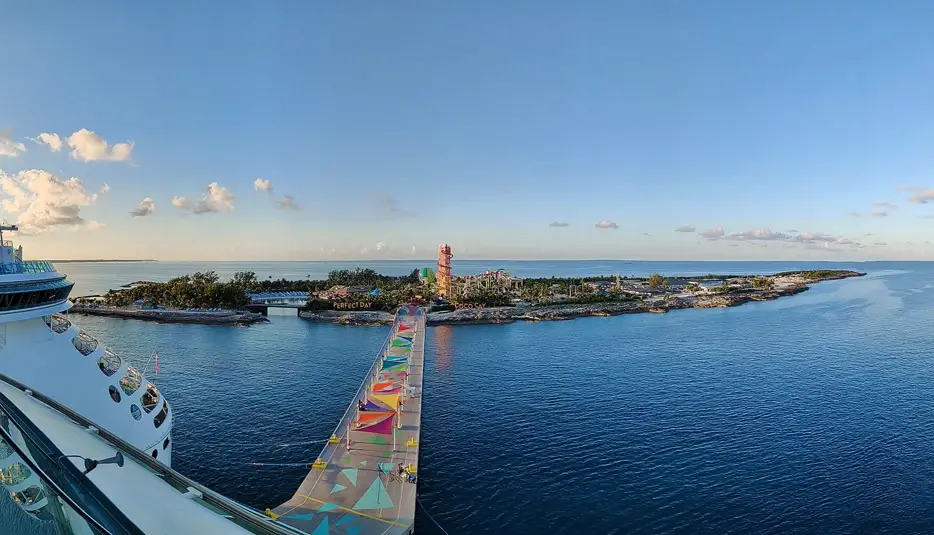
The first ship to dock at Coco Cay’s new pier has been the Mariner of the Seas on March 16, 2019. Of the new parts of the island, Royal Caribbean only opened the first part on that day. Others – notably including the water and slide park – followed later, such as Coco Beach Club in December 2019. The line won’t be able to showcase the fully completed island renovation and expansion until after the Covid-19 pandemic. On June 14, 2021, Adventure of the Seas has been the first ship to return to Coco Cay after Royal Caribbean International’s 15-month pandemic hiatus.
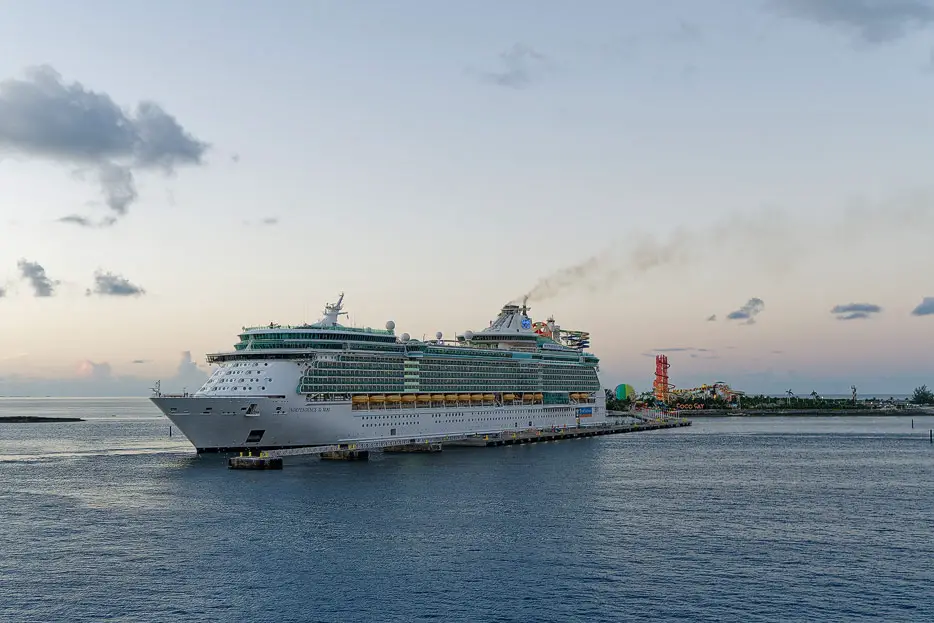
In 2023, Royal Caribbean plans to open a somewhat secluded „adults only“ beach on the north coast: Hideaway Beach. The island’s capacity will thus increase to such an extent that in the future, two Oasis Class ships – the largest cruise ships in the world – will be able to call Coco Cay at the same time without it becoming uncomfortably crowded on the island. The island should then be able to accommodate 13,000 passengers at the same time.
How Coco Cay has changed from the beginning in 1983 to today, 2024
Since 1983, pretty much everything has changed on Little Stirrup Cay aka Coco Cay, even the name of the island. But one thing has remained: Coco Cay still embodies the dream of a romantic island in the Caribbean with palm trees, cool drinks and dream beaches.
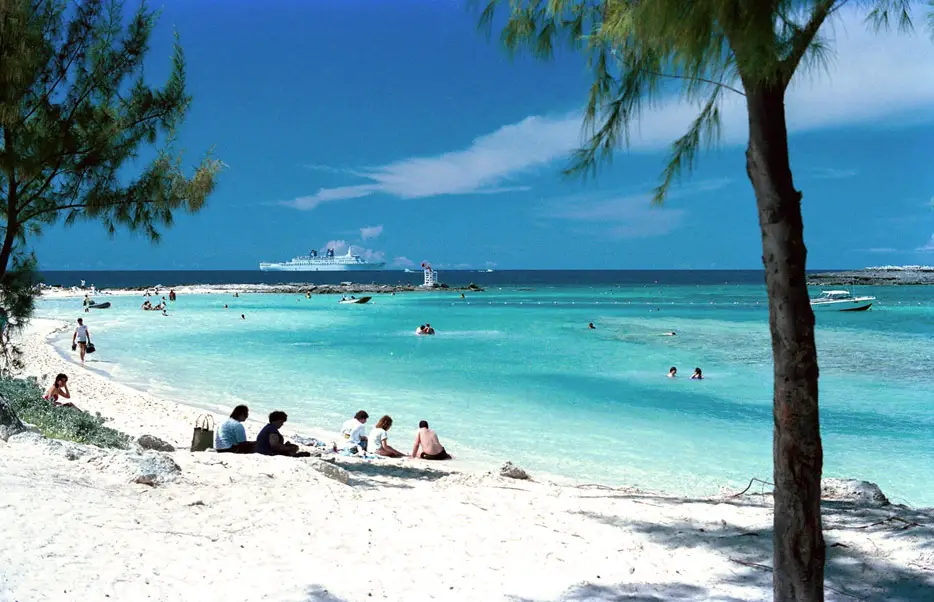
The extensive renovations and new theme park expansions did not change completely this atmosphere.
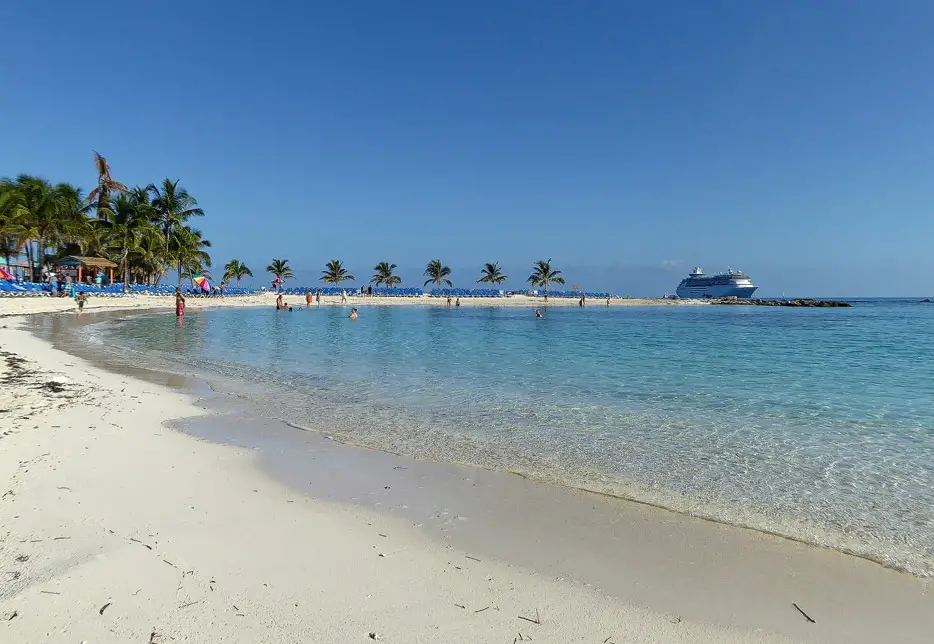
If you want, you can completely ignore all the „fun“ and just enjoy the beach, sun and sea, even on relatively secluded stretches of beach. The amusement park expansions of Coco Cay have not changed that.
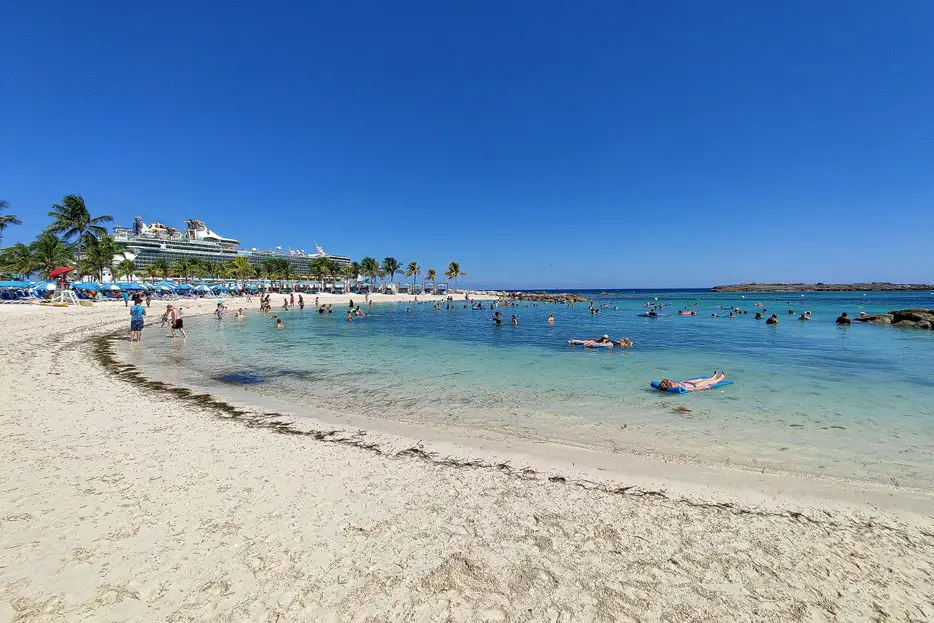
In the 1980s, there is not much more on Little Stirrup Cay than a few sun loungers and hammocks among the palm trees and a handful of souvenir stalls of the „Straw Market“. The entertainment program consists of beach volleyball and an organized treasure hunt through the island’s sparse jungle with a bottle of rum as the grand prize.
When the Emerald Seas first came to Little Stirrup Cay in 1983, there was hardly any running water on the island. Today, among other things, the tallest water slide in North America (Daredevil’s Tower) is there, and Coco Cay claims the largest freshwater pool in the Caribbean (Oasis Lagoon).
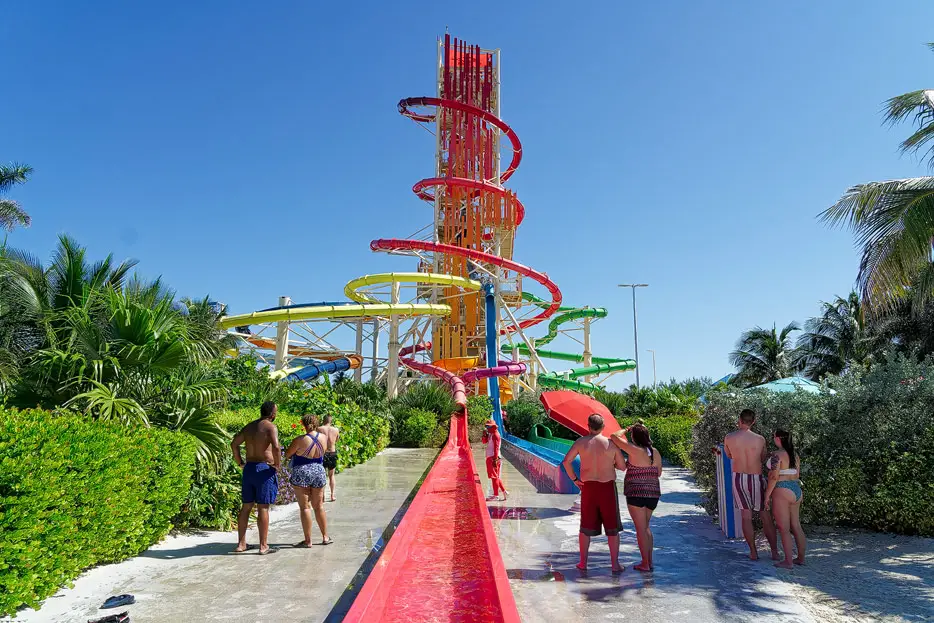
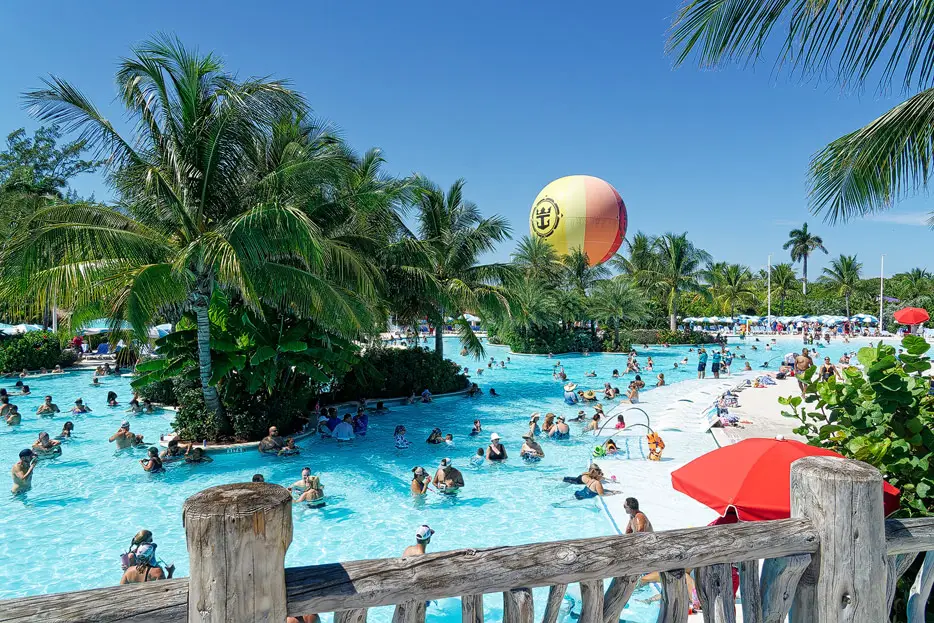
While people couldn’t even dream of mobile communications and Wifi back then, cruise tourists now post their Instagram pictures from Coco Cay via high-speed Wifi available everywhere on the island.
Less than ten people lived on the island at that time. Today there are around 540, and in addition, for example, the operators of the stores in Straw Market commute by ferry boat from the neighboring island of Great Harbor Cay.

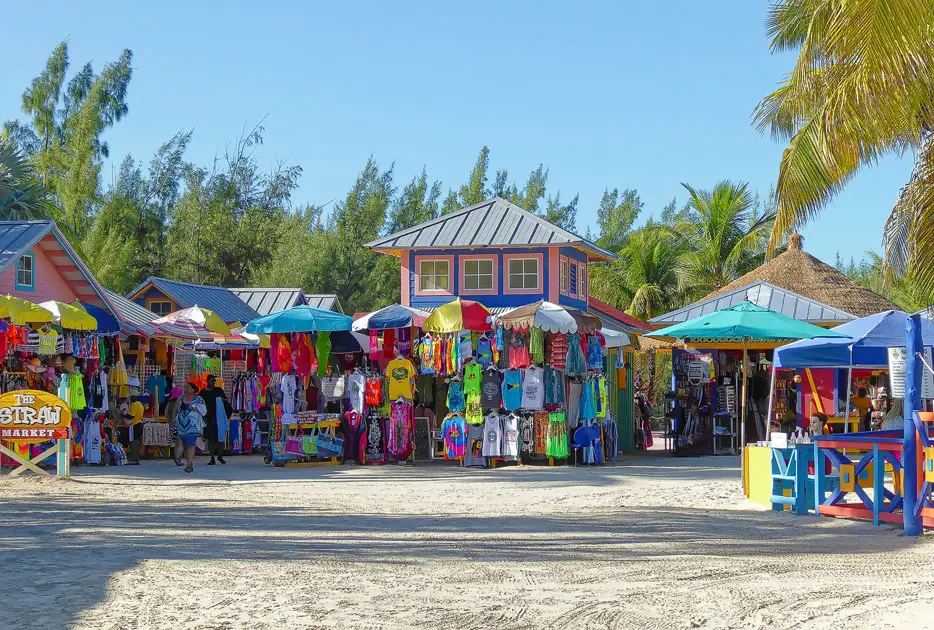
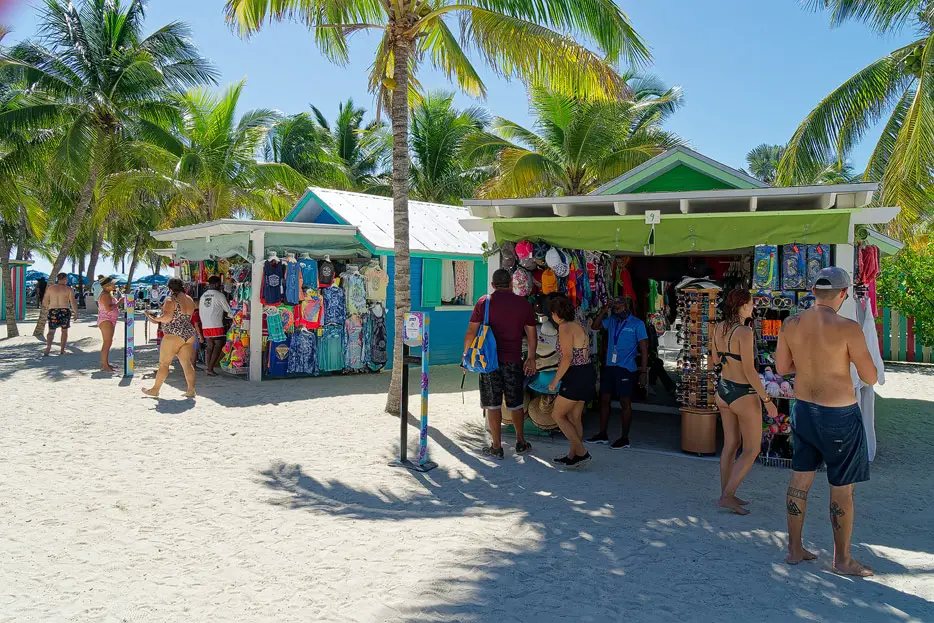
Twice a week, the 1,000-passenger Emerald Seas ship anchored off Little Stirrup Cay in the 1980s. Today, roughly speaking, more than 40 times as many people visit the island annually. In 2022, Royal Caribbean International recorded 530 cruise ship calls at Coco Cay. There are usually two ships there at the same time.
The island now comfortably accommodates over 10,000 passengers at a time. In 2023, after further expansion, there will be around 13,000 – the passengers of two of the largest cruise ships in the world, the Oasis Class, without crowding the beach.
However, the growth also leads to restrictions: For many years, passengers on Little Stirrup Cay could roam almost freely everywhere, even walking officially on the Nature Trail to the other end of the island on the western tip. Even the pretty „Sunset Point“ in the northwest was still accessible at that time.
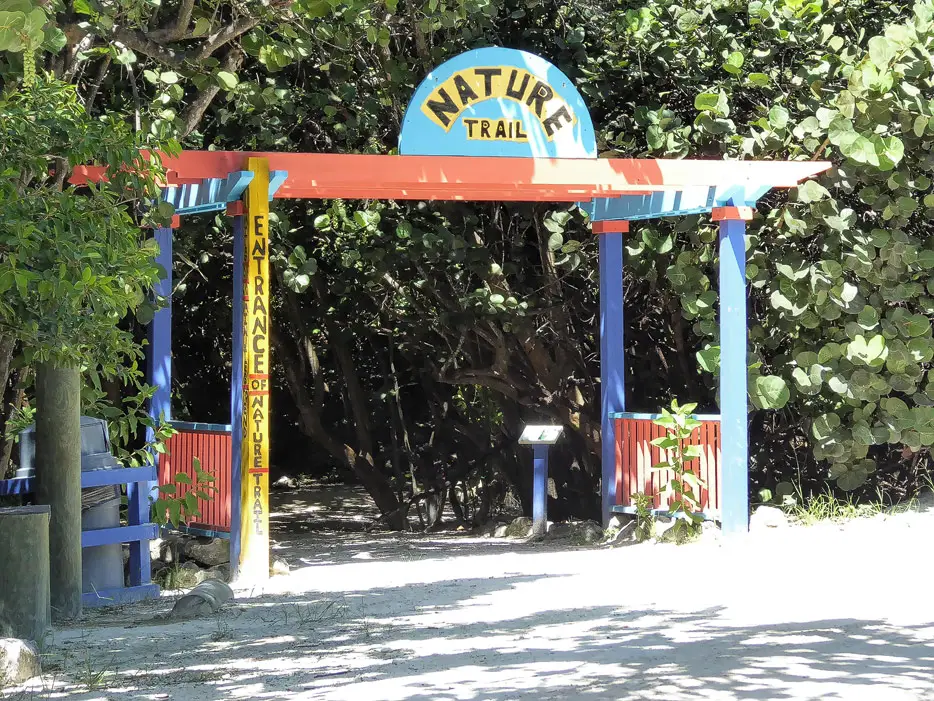
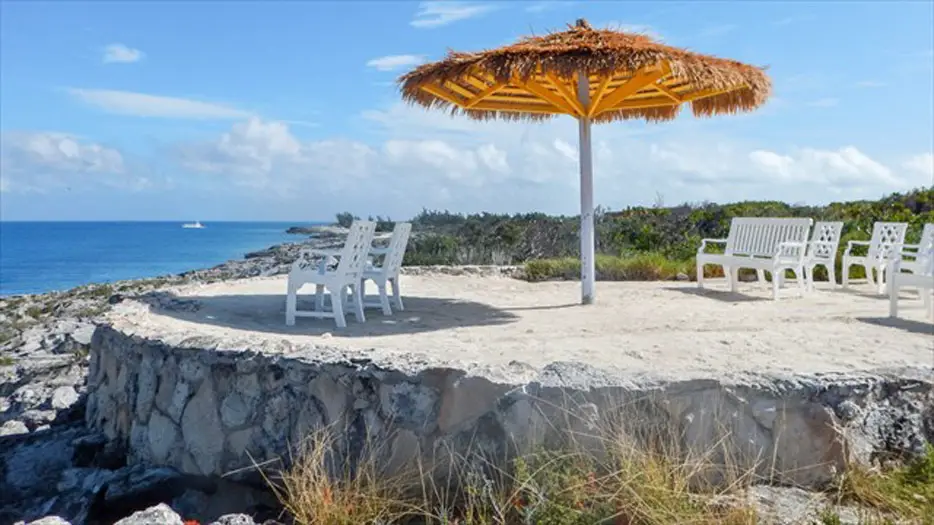
Ken Rush remembers this time: „Initially, there was also only a very small area on Little Stirrup Cay that was accessible to cruise tourists. Beyond that, however, you could walk along the beach without restriction until they more or less walked into the buildings. No one was taking care of you. You just could walk and walk, but that was not official.“
The accommodations of the employees and concessionaires who lived on the island were very basic, at least in the beginning, as Cathy Reed relates. The reverse osmosis system rarely working, they got their water in tanks from the ship, but these were usually contaminated with oil. So they used it boiled mainly for showers, „but at least we had flush toilets.“ And to drink? „Mostly we drank soft drinks – and lots of rum!“
The stone villas for the staff were set back a bit from today’s Chill Island Beach among trees and palms. Some pictures from Cathy Reed’s photo albums show what it looked like back then:
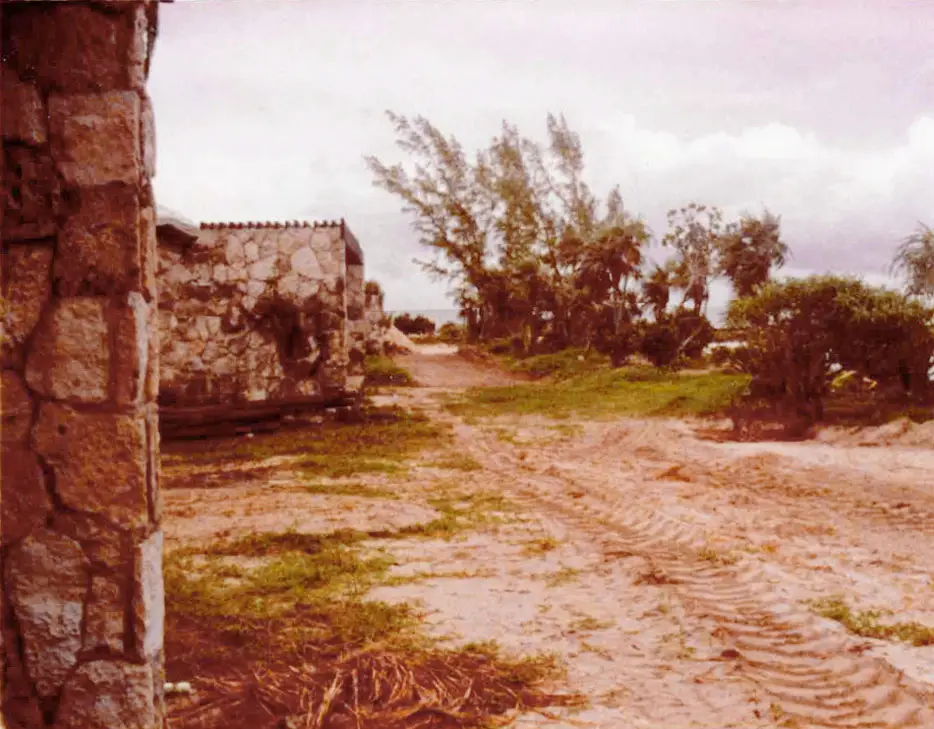
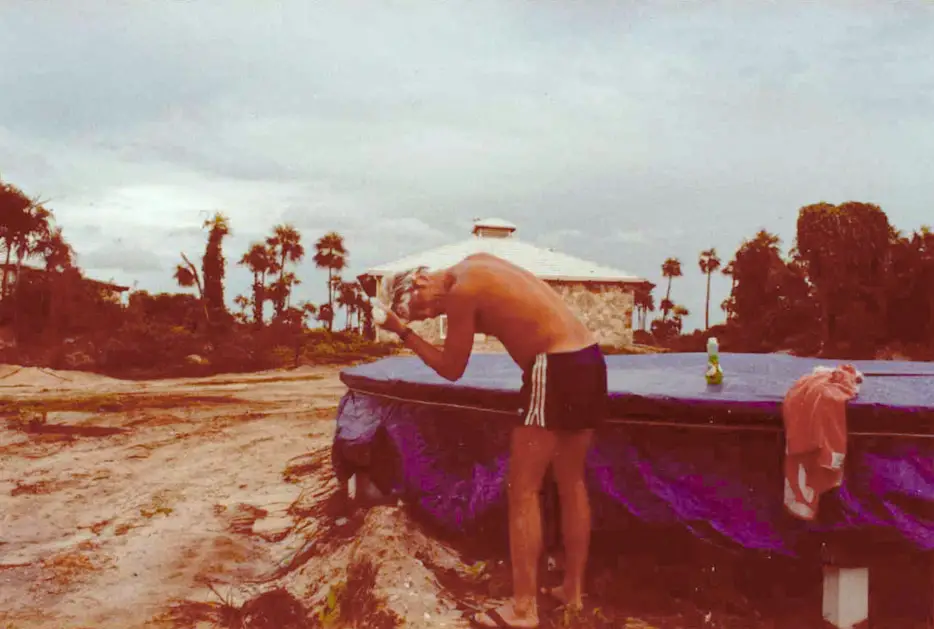
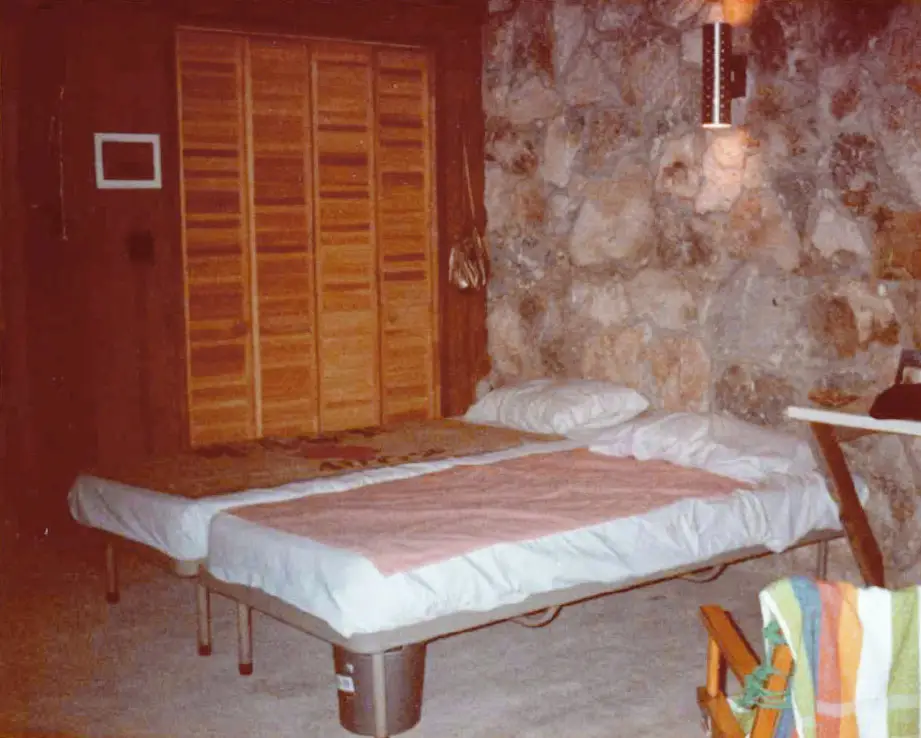
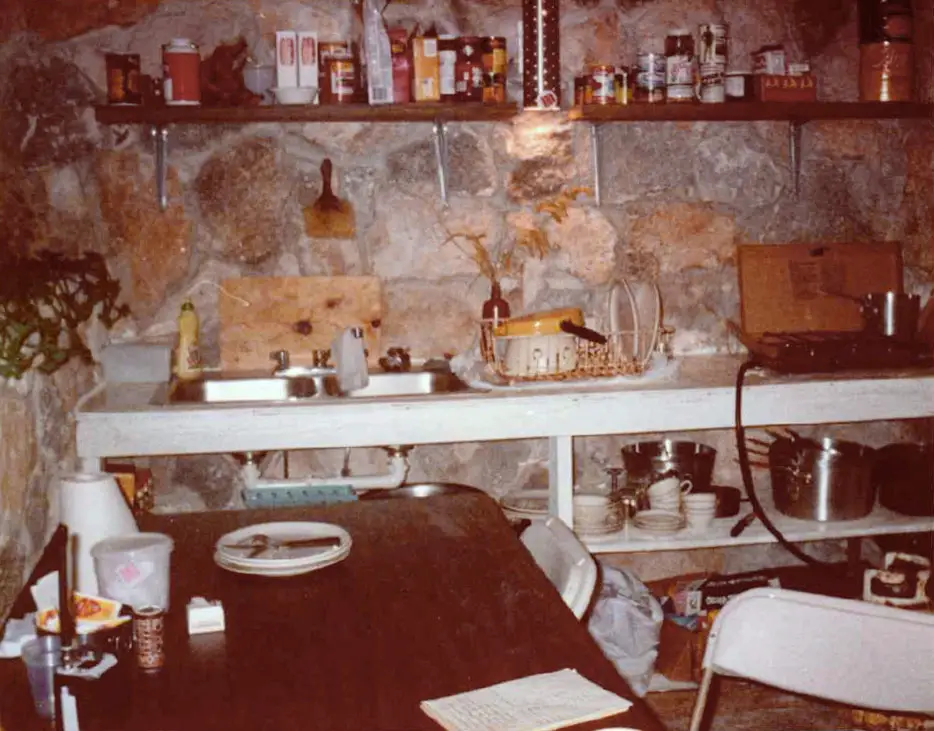

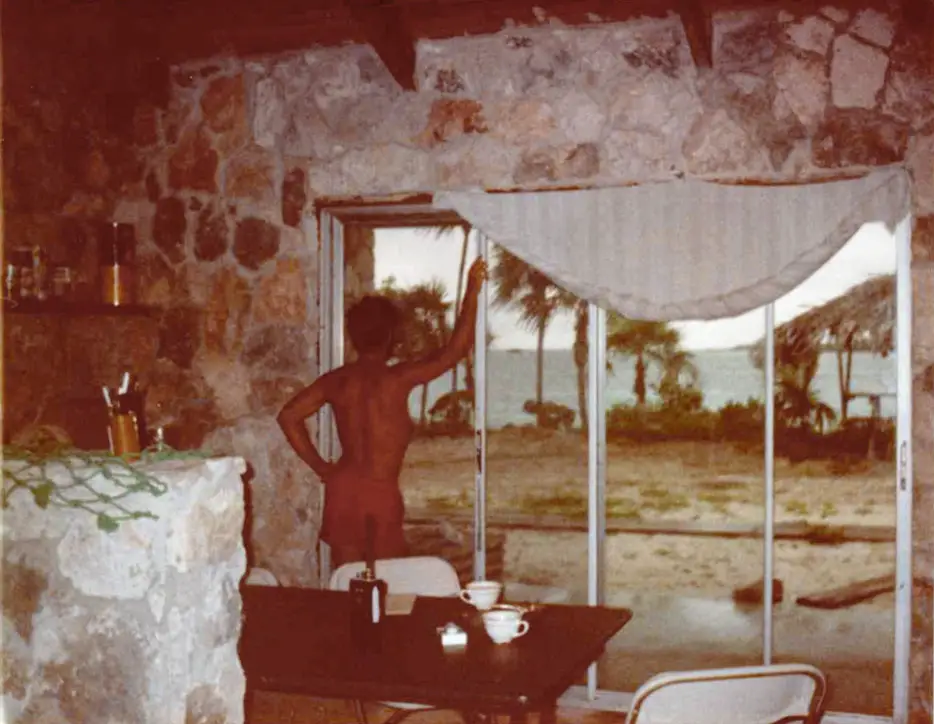
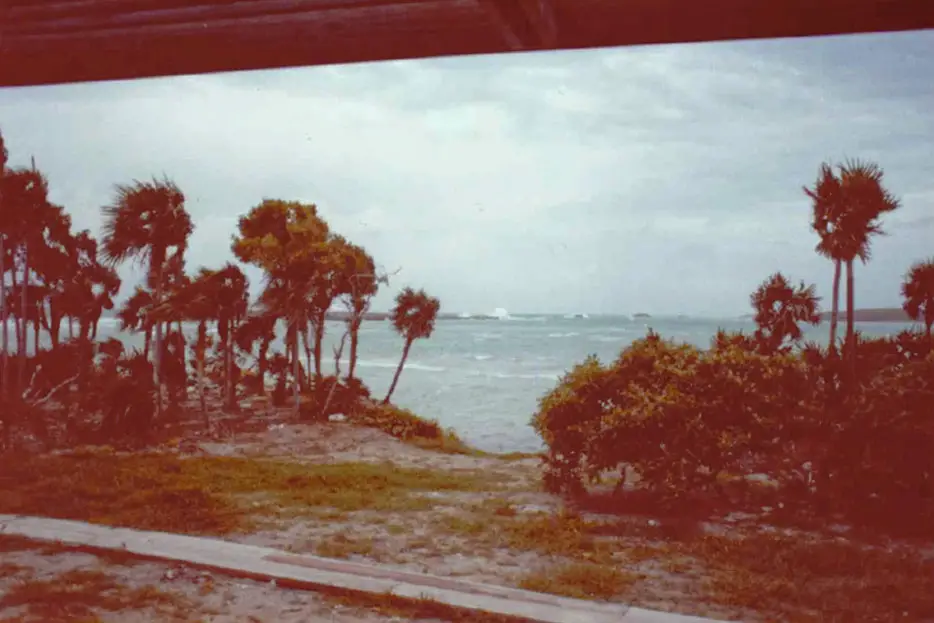
Cathy Reed continues, „There was no air conditioning, and it was often unbearable, even with the doors open. We didn’t like to keep the doors open as there were so many rats. They would chew through the screens, and we could feel them running over our legs in the night. We eventually kept the doors closed and endured the heat.“ – „… a paradise,“ she adds sarcastically.
As the island expanded, Royal Caribbean paid closer attention to ensuring that passengers did not leave the official areas, if only because the many employee residences and service buildings also required a certain degree of privacy as the number of passengers increased. And so, since the major reconstruction in 2019, access to the part of the island west of the freely accessible area is now blocked.
Coco Cay in transition: a comparison with island maps and satellite images
The constant expansion of Coco Cay to today’s most spectacular of all private islands of cruise lines is well comprehensible on island maps of Royal Caribbean. Three versions from after 1990, 2016 and currently from 2022 give an impression:
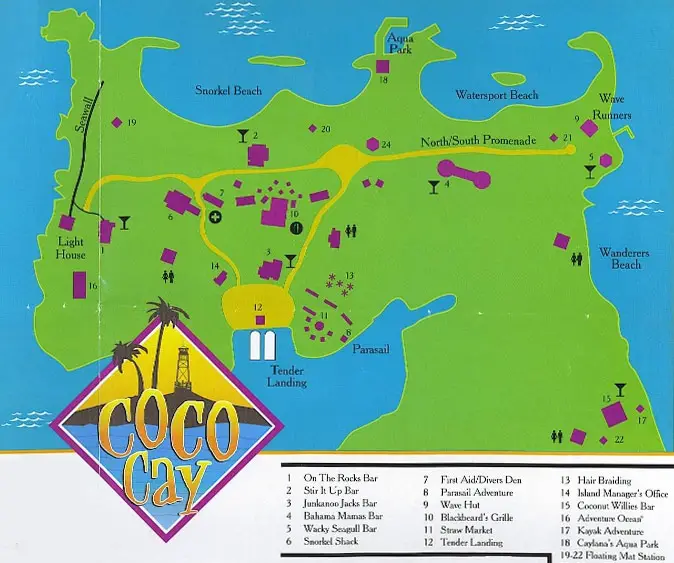
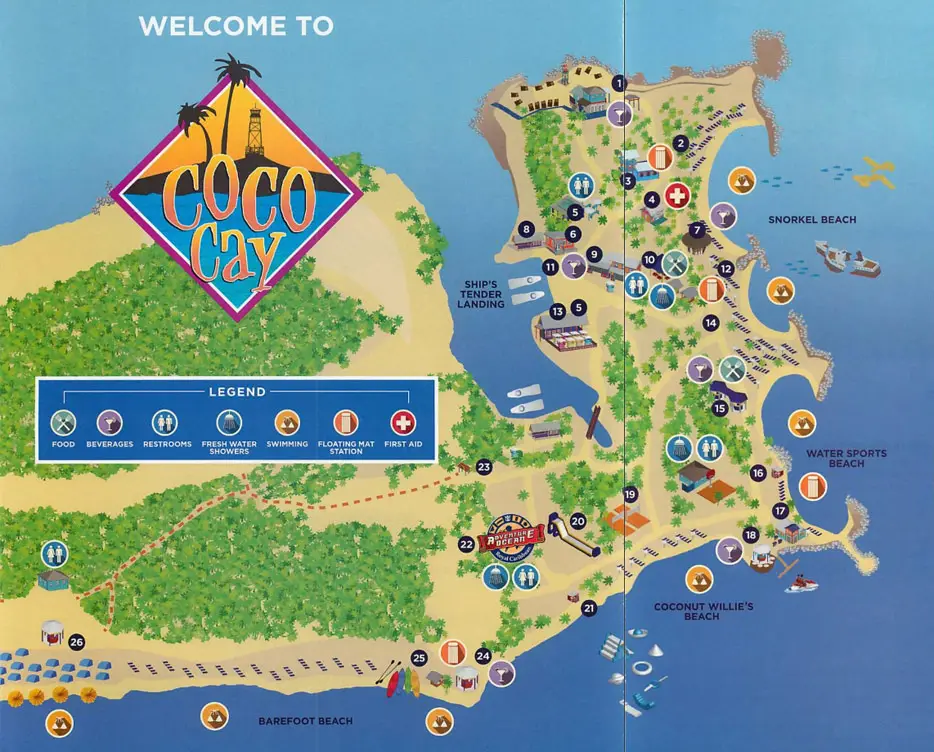
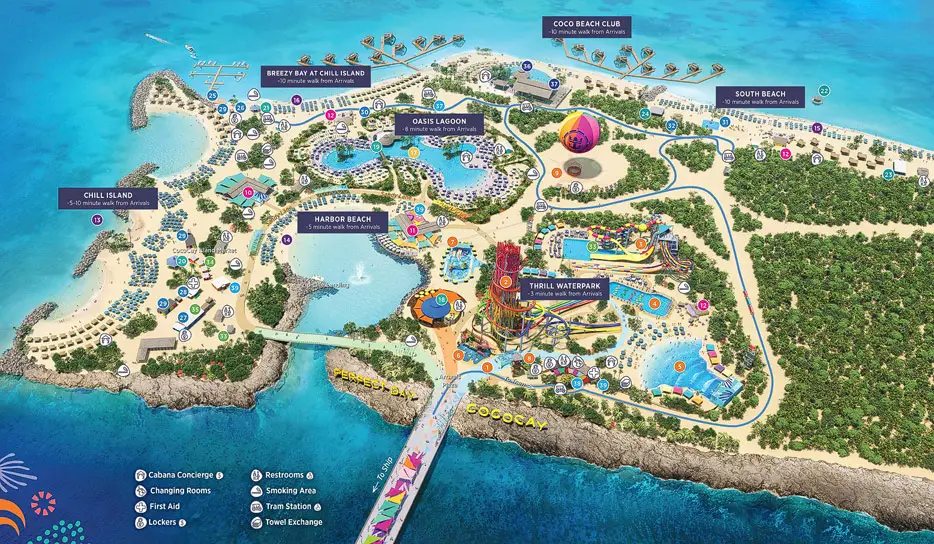
The most noticeable changes brought the massive expansion of Coco Cay to 2019, when Royal Caribbean notably built the new pier so ships can now dock directly and passengers no longer have to use tender boats, as well as the Thrill Waterpark and the expansion of the previous tender port into the new Harbor Beach.
Google Earth’s satellite images vividly show the difference …
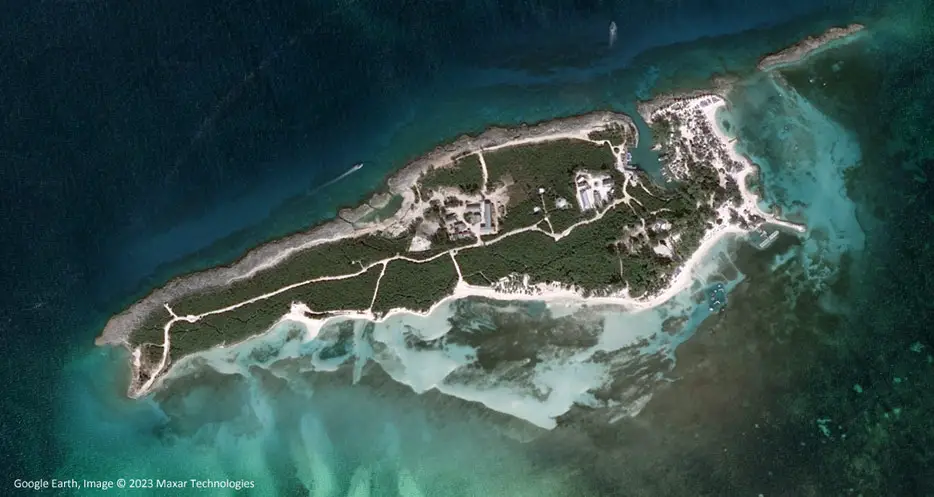
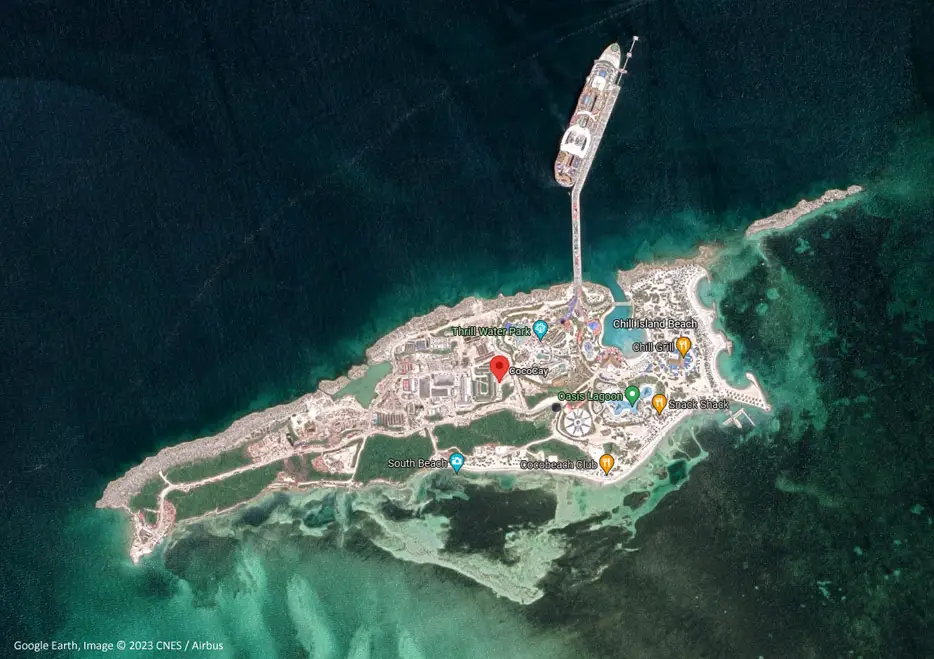
… and also when comparing the silhouette of the island you can see the differences really clearly (even if the angle of the two photos is not identical, so the island looks a bit flatter on the lower shot from 2022):

When drug traffickers were still around in the Bahamas …
However, something has changed particularly clearly that cruise ship passengers had not noticed at all: In the 1980s in particular, the so-called „Cocaine Cowboys“ were up to their mischief in the Bahamas – drug traffickers, tolerated by the corrupt Bahamian government, including those of the Medellín Cartel, who traveled with speedboats and used islands like Little Stirrup Cay as temporary drug hideouts.
Cathy Reed, dive instructor on Little Stirrup Cay in the mid-1980s, recalls, „The island was a pretty wild place when the ship wasn’t there. At one point, we accidentally stumbled upon a cocaine drop on the island and were fired upon with a rifle. We stumbled onto hundreds of bales of cannabis waiting for pickup in the jungle and were threatened by guys carrying machine guns.“
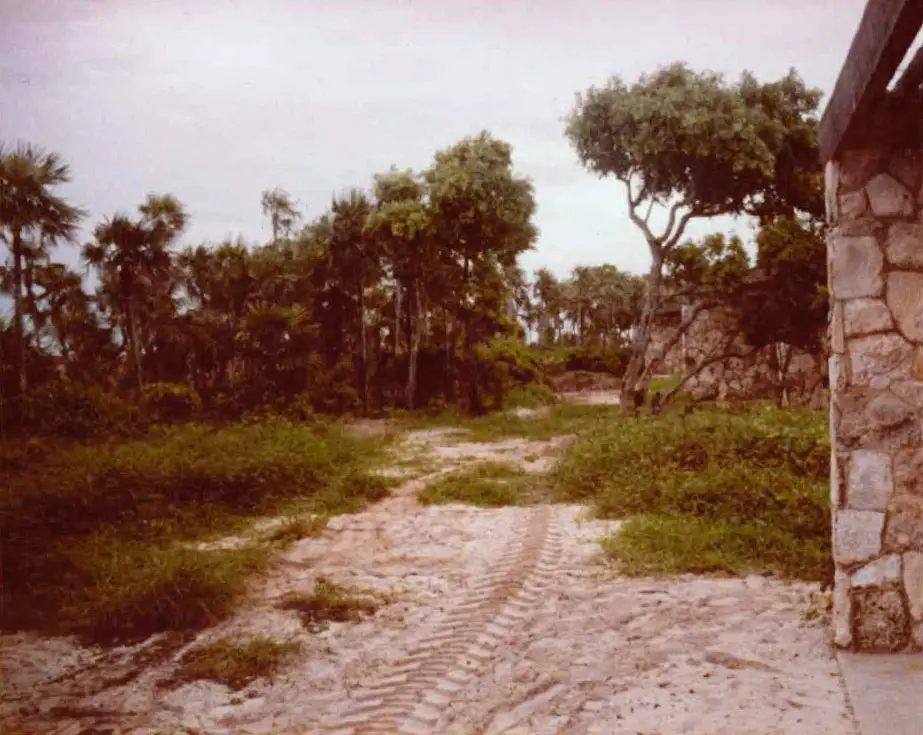
Those days are long gone. Thanks to close cooperation with the U.S. authorities, the drug situation in the Bahamas has changed fundamentally. The drugs have long since found their way to the U.S. via other routes and using much more sophisticated transport methods than speedboats through the middle of the Bahamas.
Indirectly, however, drug trafficking and alleged corruption in the Bahamian government in the 1980s has led to Coco Cay being an island paradise for cruisers today, rather than a research paradise for scientists. Because, as we’ve quoted David Ruzic before, „the only two businesses the government recognized were drug smuggling and tourism.“
And what about the original flair of the island?
Many who knew Little Stirrup Cay from its days prior to 2019 worried about the island’s wild and innocent charm in light of the expansion plans. What would a thrill water park mean for the tranquility and beach-sun-sea experience at Coco Cay? How would people perceive the helium balloon hovering over the island?
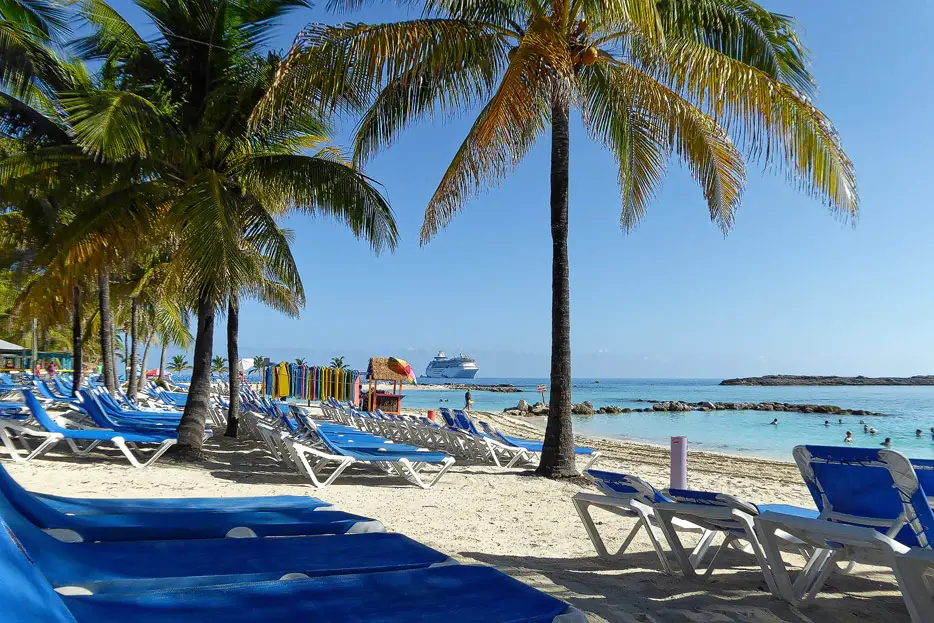
Before the expansion and renovation, passengers enjoyed the fact that chickens cackled on the island every now and then or a large iguana posed for photos along the way. Would passengers still be able to experience this?
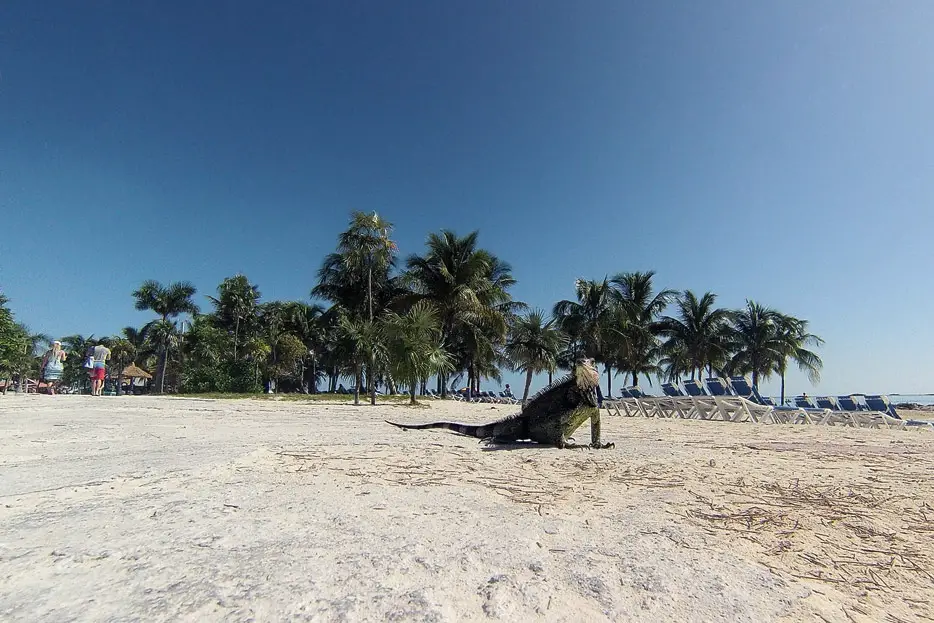
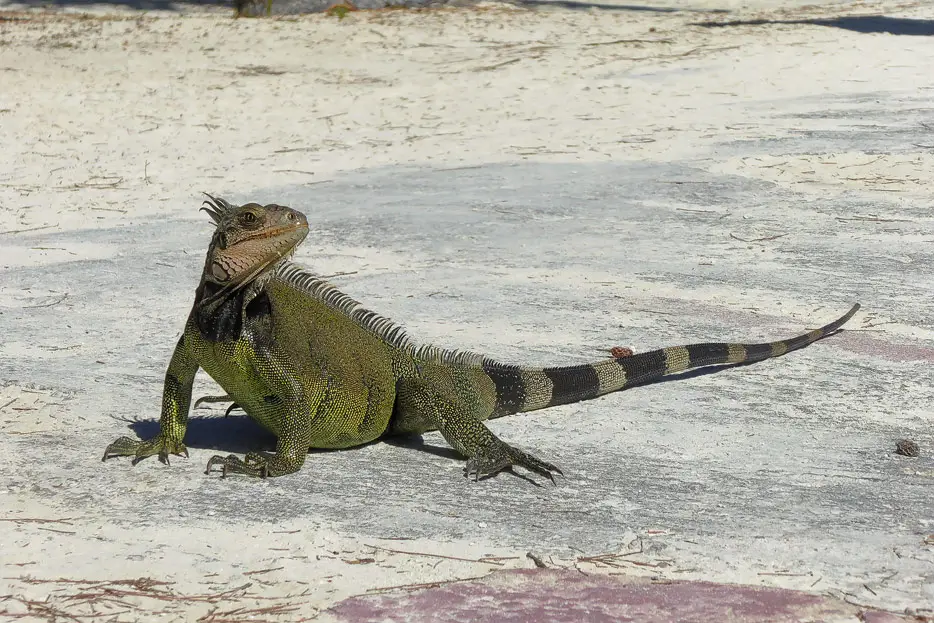
The short answer is: Yes, part of this flair has been preserved until today, but you hardly meet chickens or iguanas anymore. The ever-increasing number of passengers on the island over the years have also meant that the island no longer appears wild and untamed.
The western part of the island is no longer accessible, but due to the many new maintenance buildings there, it is also no longer as attractive as the original, sparse primeval forest from the early days. But almost deserted, quiet stretches of beach where you can enjoy the original island experience, are still.
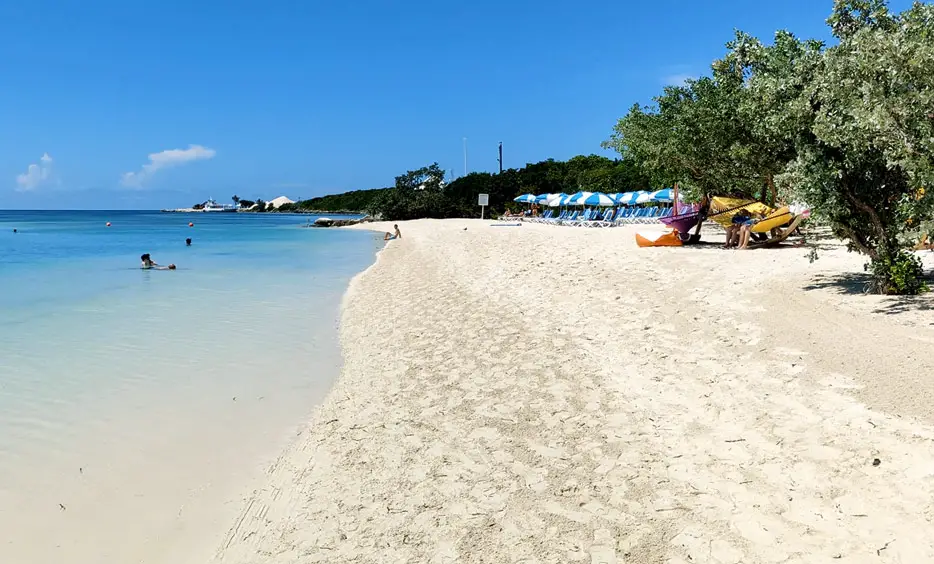
Surprisingly, such considerations already existed during the first, comparatively low-impact expansion of the island in 1990, as Ken Rush recalls: „It was something different from all the other ports of call because it’s our own, and we can make it our own. We can make sure that the guests have a good time. Even back then, to be honest, there was this concern that we’re going to ruin the feel of Little Stirrup Cay when we started building all these things.“
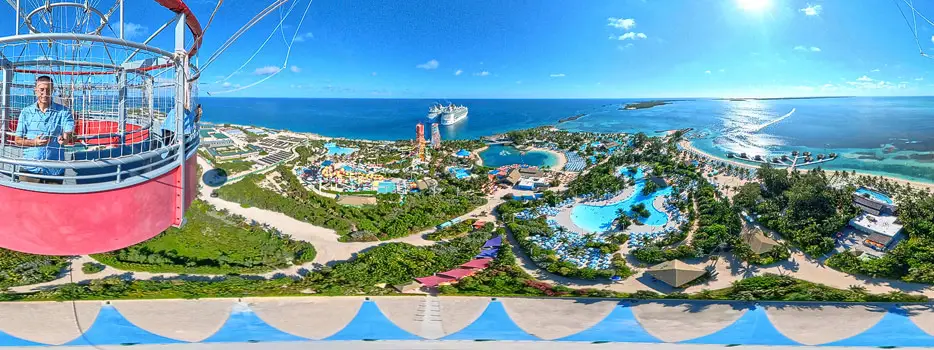
And today? Ken Rush: „I don’t think we spoiled anything, I don’t think we spoiled the charm of that island. It’s still there. If you choose to go to this side or that side of the island, you can chill, or you can get involved as much as you want. You can be the thriller, you can do all the different stuff you really want to without spoiling anything, which I think is really, really great. It just gives you so many options, and it’s beautiful. For example, if you go to the Coco Beach Club, what the horticulturist did with all the trees and shrubs, it’s beautiful. You don’t find anything like that anywhere else, it’s pretty amazing.“
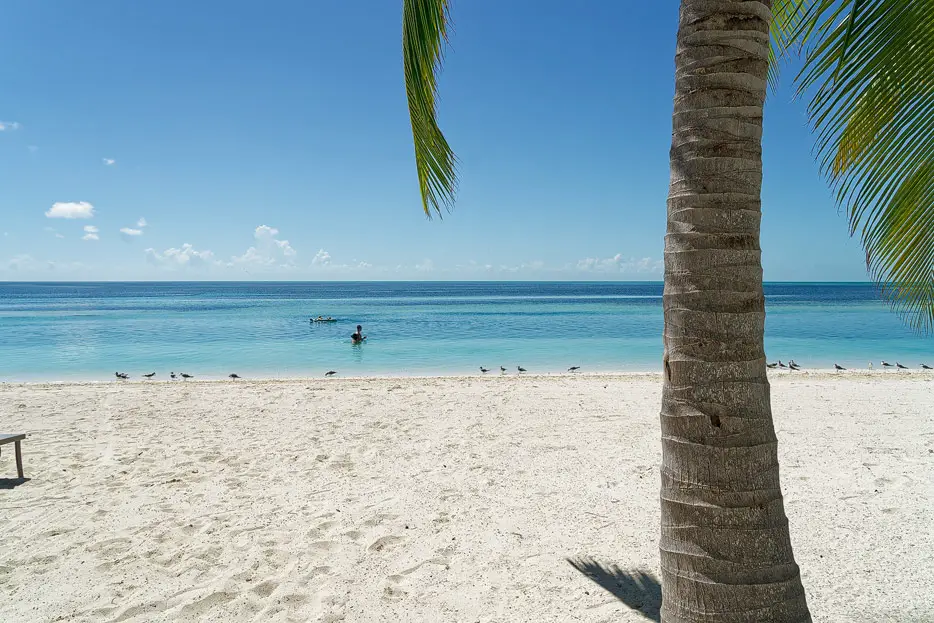
Cruisetricks.de sincerely thanks David and Carol Ruzic, Cathy Reed, Ken Rush, Al Parker, Chris Gray Faust from Cruise Critic and several others for the information and their time in contributing to the research on Little Stirrup Cay aka Coco Cay. Unmarked photos: Franz Neumeier & Carmen Winkler.

